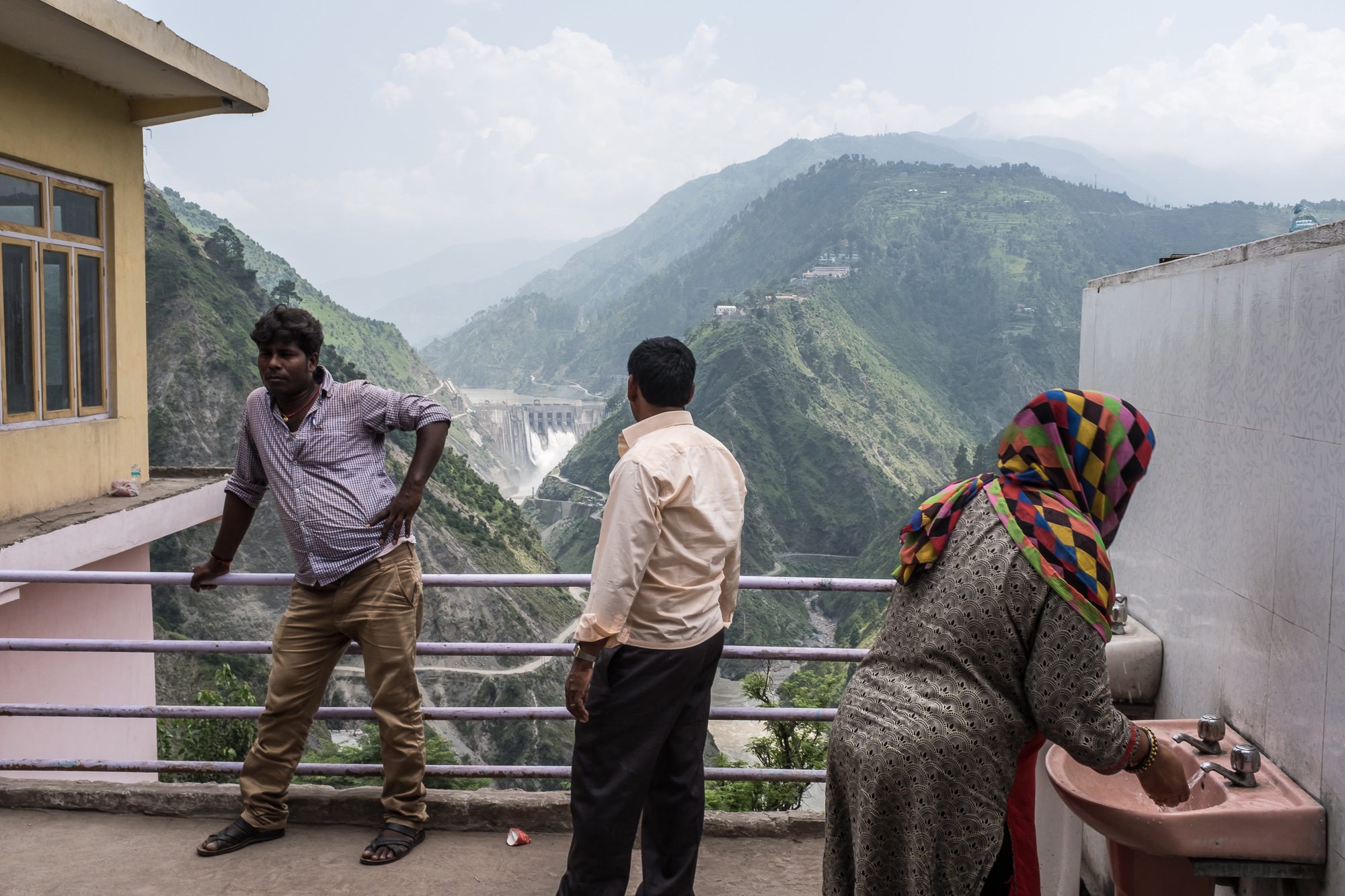
Saving the Indus River • Brendan Hoffman
The Indus River, one of Asia's longest, originates high on the Tibetan plateau of western China, drawing additional water from the glaciers of India before crossing the border and flowing the length of Pakistan. It is used for extensive irrigation of commercial and food crops, industry, and to provide hydroelectric power. It is a vital resource, especially for India and Pakistan, yet several factors are making heavy reliance on the Indus increasingly difficult to sustain.
First, the Indus flows from Pakistan's rival India, which thanks to an extensive and growing dam network has the power to drastically reduce the water allowed through to Pakistan. A 1960 treaty defines which Kashmiri headwaters India and Pakistan control, though recent military disputes and disagreements over India's efforts to utilize the river in its territory have raised questions about its ability and intention to essentially weaponize water.
Second, climate change is affecting the monsoon rains and many of the glaciers that are a major source of the river's water, throwing into doubt both India's and Pakistan's long-term economic dependence on the river. Paradoxically, this has contributed to recent flooding as some glaciers melt more than normal, but once they have shrunk water flows will be less than necessary to sustain the economy built on the Indus. Only a small fraction of the thousands of glaciers feeding the Indus have been studied in a meaningful way, and so the ultimate consequences of climate change are poorly understood.
Finally, Pakistan, with a rapidly growing population, has the most water-intensive economy in the world, and is already water-stressed based on the amount of fresh water available per person. Its economic reliance on the Indus is extreme; in addition to rice and wheat, the water-intensive cotton and textile industries make up a significant part of its GDP and foreign exchange earnings. Major changes are necessary to make agriculture and irrigation more efficient, yet to do so will require scientific advances and taking on corrupt interests unlikely to yield.
As the political and economic stakes continue to grow, will the dispute over the Indus launch a water war?

Buddhist pilgrims at the Drolma La, the highest point of the kora around Mount Kailash (5630 meters, or nearly 18,500 feet) take selfies on Thursday, September 12, 2019 in Burang County, Ngari Prefecture, Tibet, China. The mountain is considered sacred by four different religions: Buddhism, Hinduism, Bön, and Jainism. The kora is a circumambulation of the mountain, clockwise for all but Bönpo, on a path that covers 56 kilometers, or 35 miles.
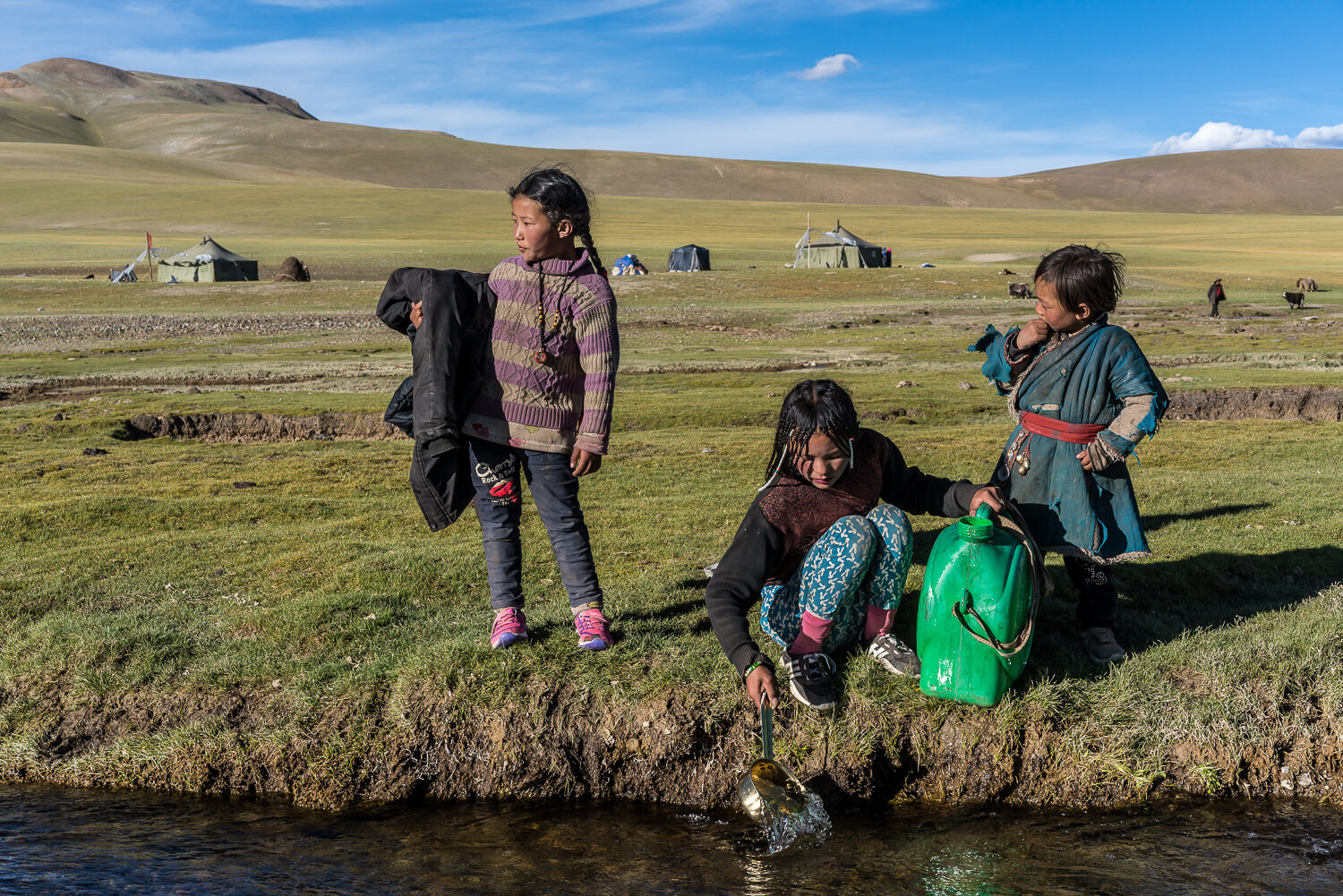
Kalzang Tseden, 14, center, collects water from the Indus River as Yeshi Lhumu, 7, left, and Samnor, 5, right, watch near their nomad camp along the Indus River on Friday, September 6, 2019 in Gê'gyai County, Ngari Prefecture, Tibet, China.
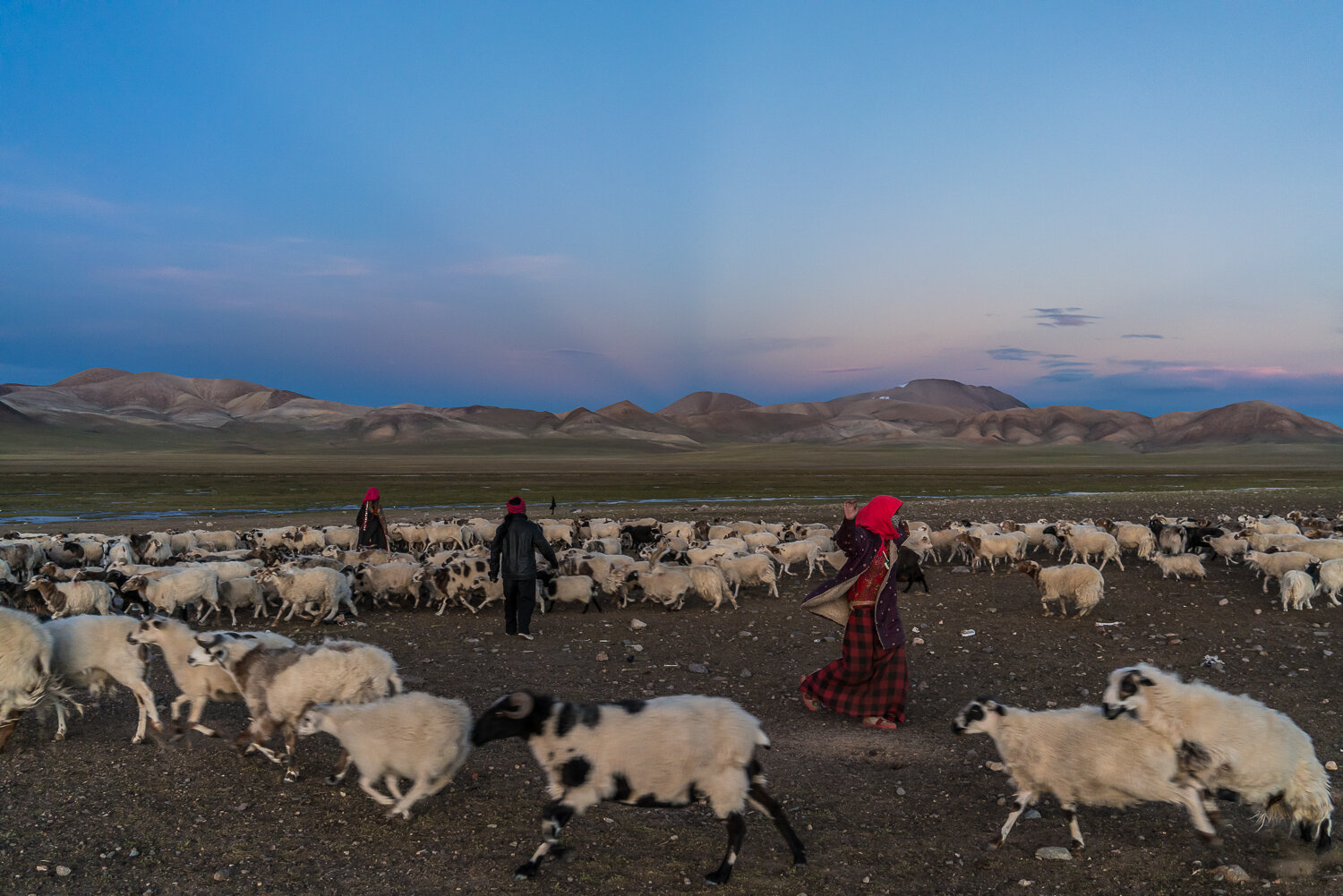
Gudong, 19, Thupthen, 39, and Choezang, 38, from left, herd their sheep and goats together for the night near her nomad camp along the Indus River, summer pastures which residents refer to as Yakra Changma, on Friday, September 6, 2019 in Gê'gyai County, Ngari Prefecture, Tibet, China.

Tashi Norzang, 48, a Buddhist pilgrim from Ali, prays at the north face of Mount Kailash on Wednesday, September 11, 2019 in Burang County, Ngari Prefecture, Tibet, China. The mountain is considered sacred by four different religions: Buddhism, Hinduism, Bön, and Jainism. The kora is a circumambulation of the mountain, clockwise for all but Bönpo, on a path that covers 56 kilometers, or 35 miles.
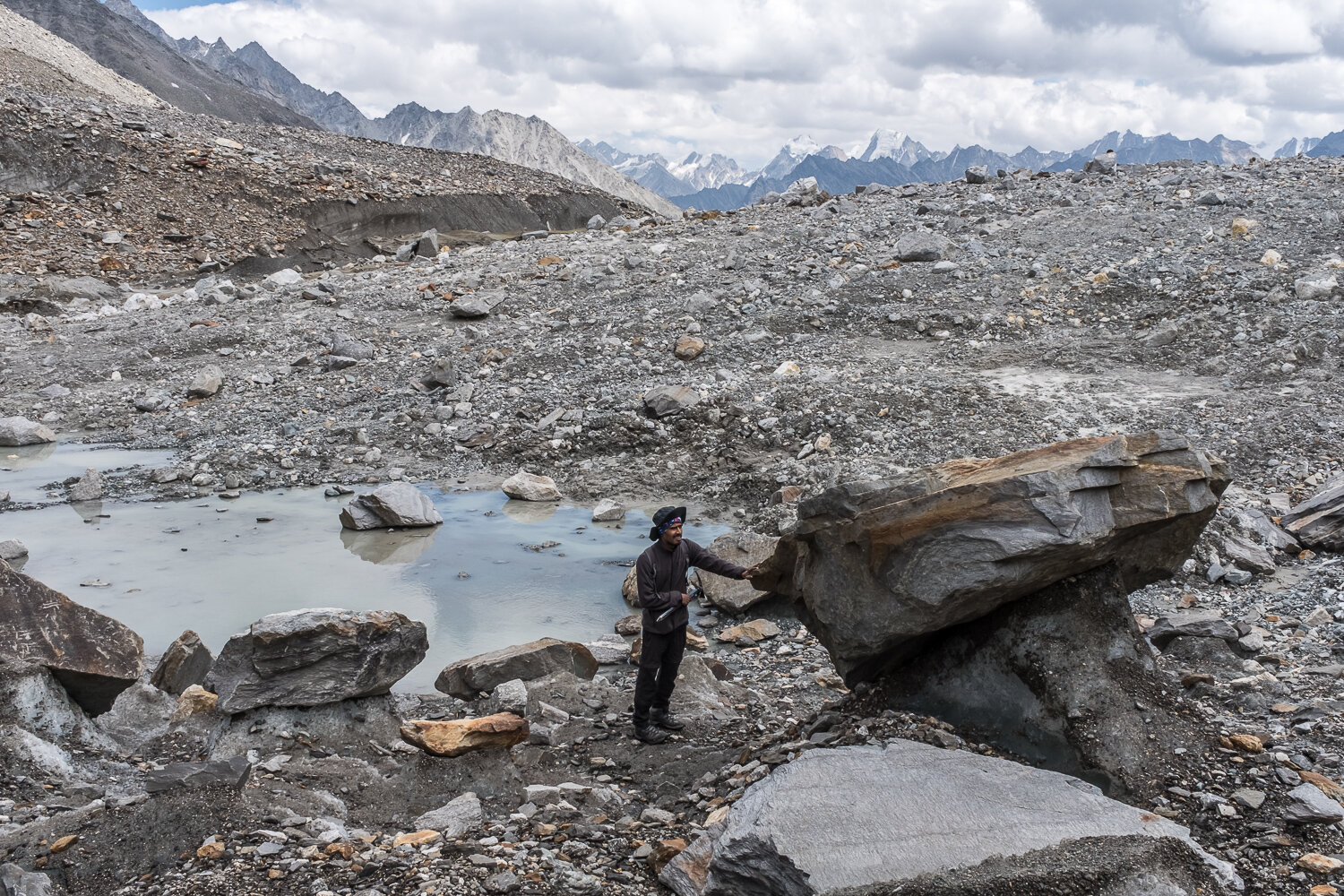
Suresh Das, 25, a graduate student studying glaciers at Jawaharlal Nehru University, on the accumulation zone of the Menthosa glacier on Friday, August 18, 2017 on Mt. Menthosa, Himachal Pradesh, India. Das and a team of other graduate students will spend approximately two weeks studying the Menthosa glacier, the meltwaters of which ultimately feed the Indus River.
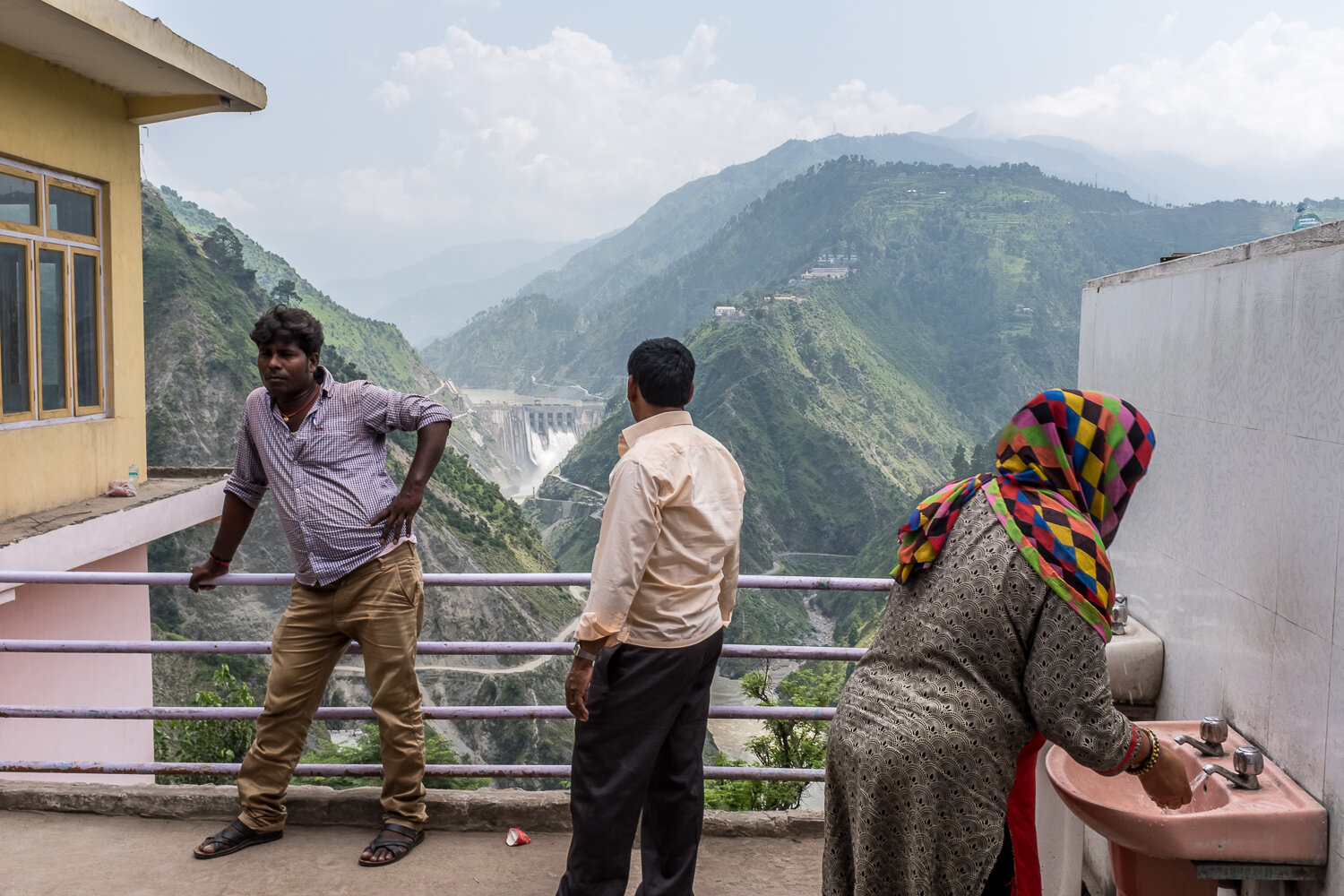
The Baglihar Dam, a hydroelectric power project on the Chenab River, stands in the valley behind patrons of a roadside cafe on Wednesday, August 9, 2017 in Baglihar, Jammu & Kashmir, India. The Chenab River is one of the major tributaries of the Indus.
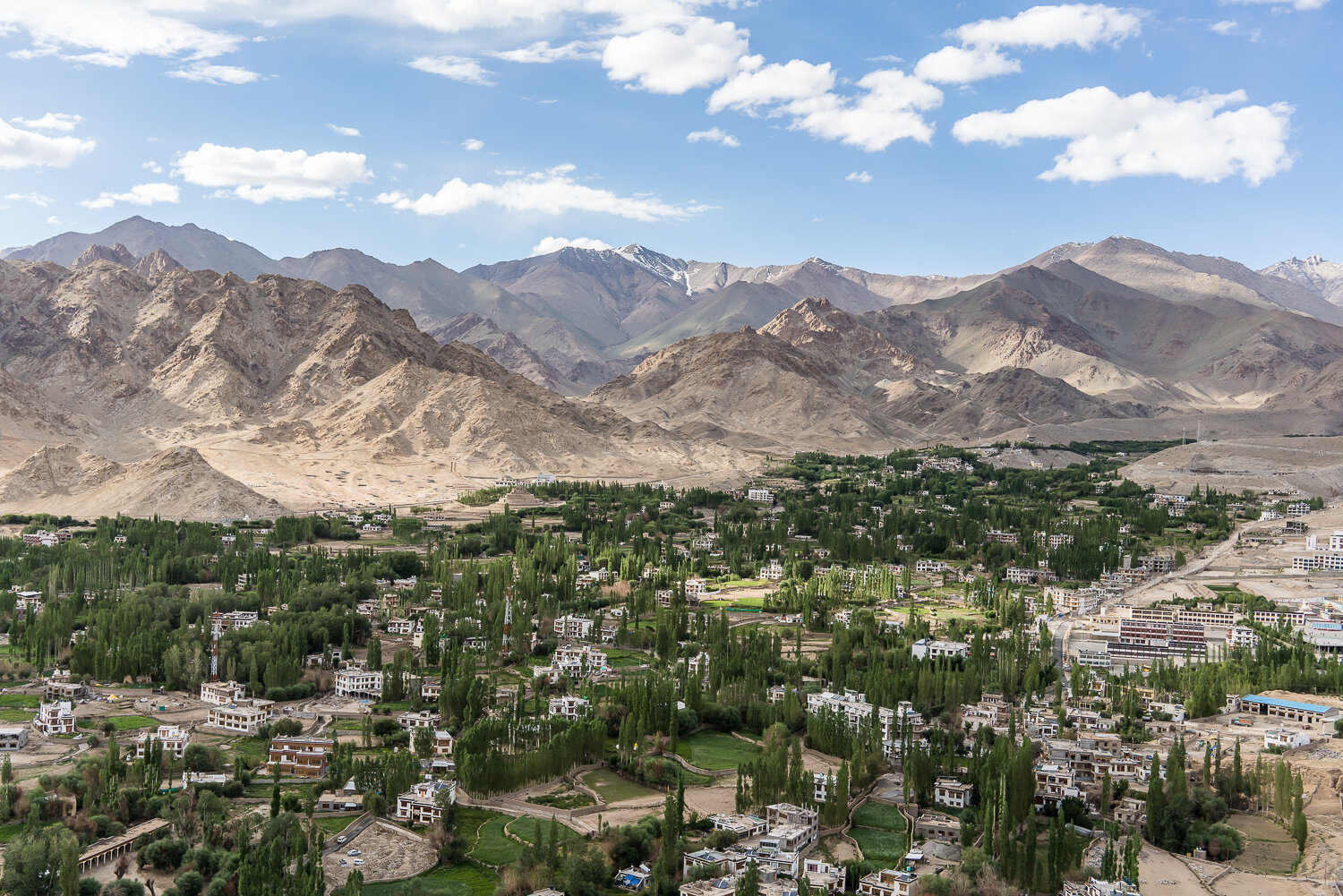
A view of the city from the Namgyal Tsemo Temple on Thursday, August 8, 2019 in Leh, Ladakh, India. The green areas reflect the original settlement of the valley with ready access to streams and springs.
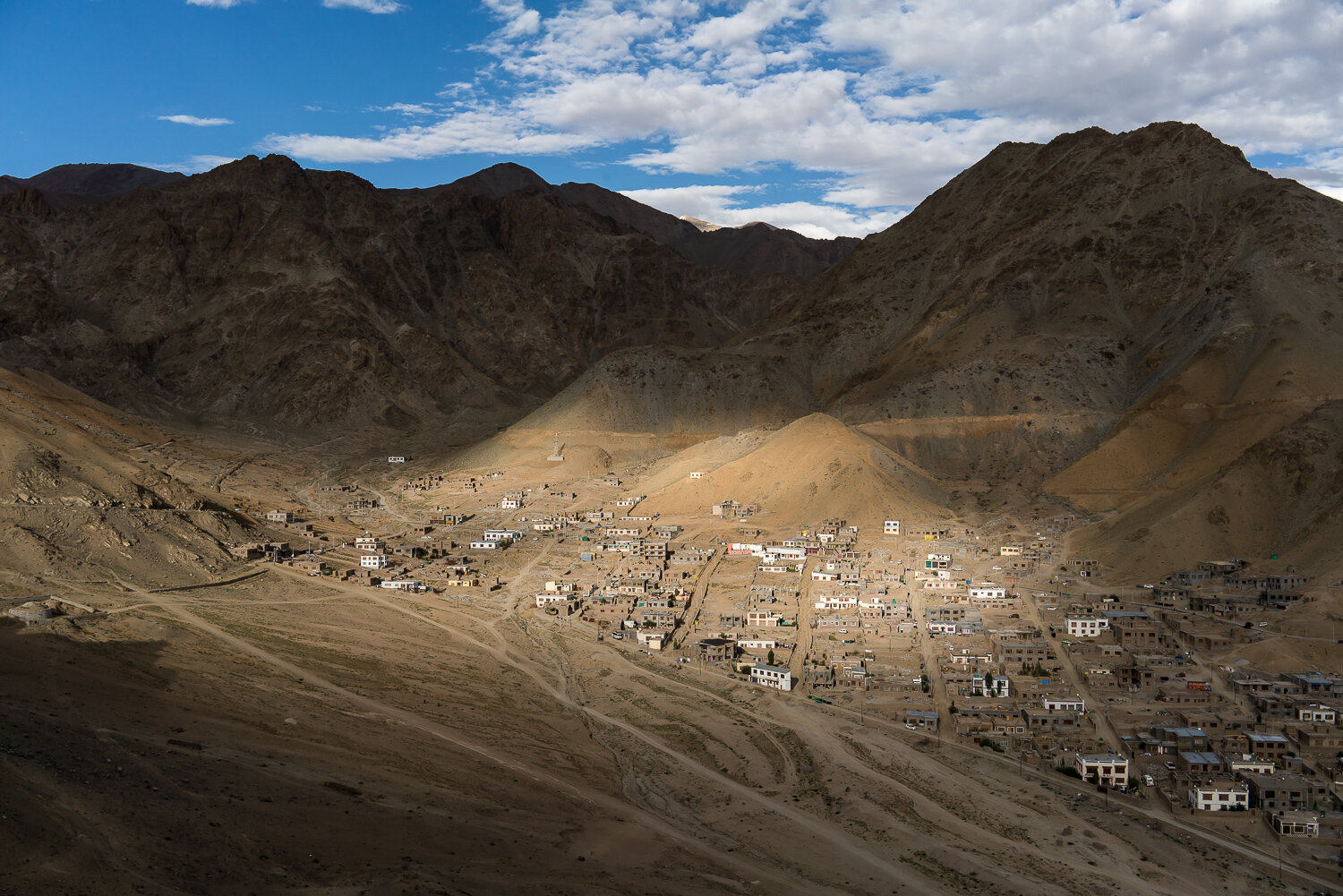
The rapidly-expanding Skampari neighborhood, which does not enjoy the same ease of access to fresh water as some other areas of the city, as seen from the Namgyal Tsemo Temple on Thursday, August 8, 2019 in Leh, Ladakh, India. As Leh expands, the supply of natural resources such as water are unable to keep up with demand.

Sisters Tashi Yangzom, left, and Tsering Dolma prepare dinner at home on Thursday, August 15, 2019 in Sharnos, Ladakh, India.

The floor of a house is covered with standing water after the canal slicing through town flooded at around 7am that morning on Tuesday, August 8, 2017 in Nai Basti, India. Many of the 150 houses in the village were damaged by the flooding.
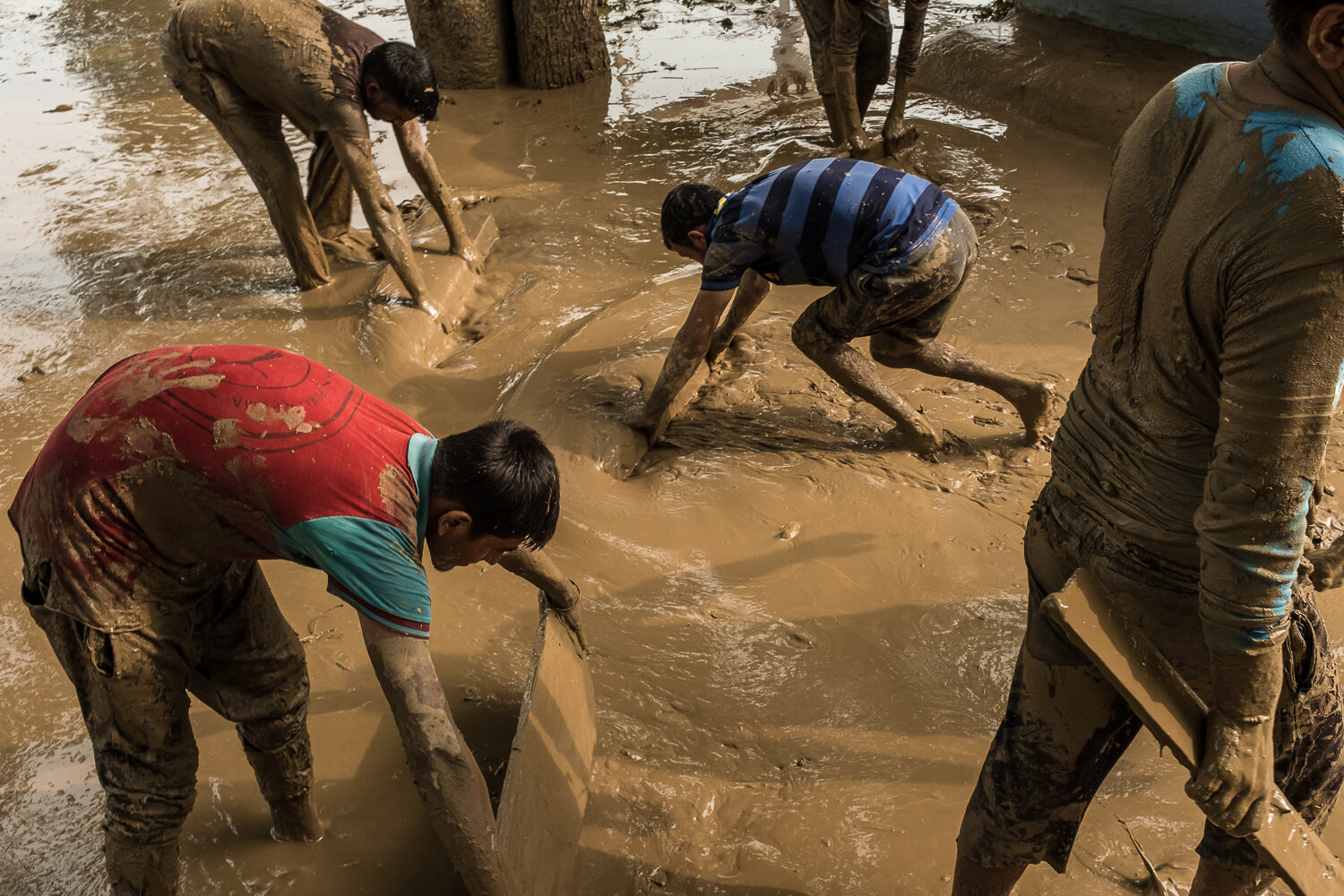
Men clean their local Hindu temple after the canal slicing through town flooded at around 7am that morning on Tuesday, August 8, 2017 in Nai Basti, Jammu & Kashmir, India. Many of the 150 houses in the village were damaged by flooding.
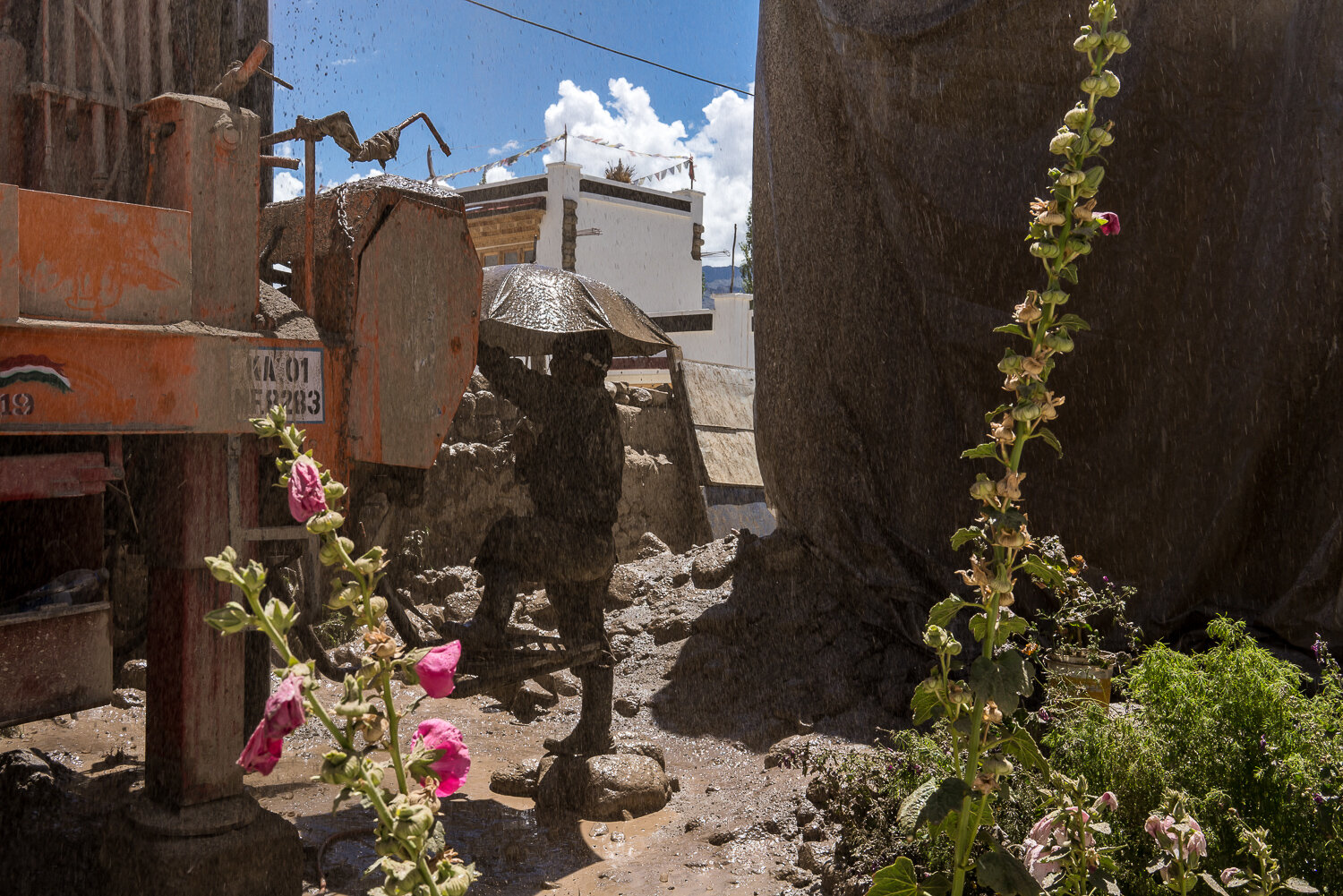
Deepak Raula shields himself under an umbrella while operating the rig drilling a bore well to provide water to a home on Monday, August 12, 2019 in Spituk, Ladakh, India. The workers, from a company called Namgayal Well, provide a valuable service to those who live in an area with accessible ground water and can afford to have a private well intalled in the high-altitude desert of Ladakh.

Boys cool off in the cold water of a canal fed by the Chenab River on Thursday, August 10, 2017 in Jammu, Jammu & Kashmir, India. The Chenab is one of the tributaries of the Indus River, originating the glaciers of the Himalayas.

Nirmal Singh, center, and other migrant workers from northern India cut plants for winter fodder for animals in a poplar grove on Sunday, August 11, 2019 in Alchi, Ladakh, India.
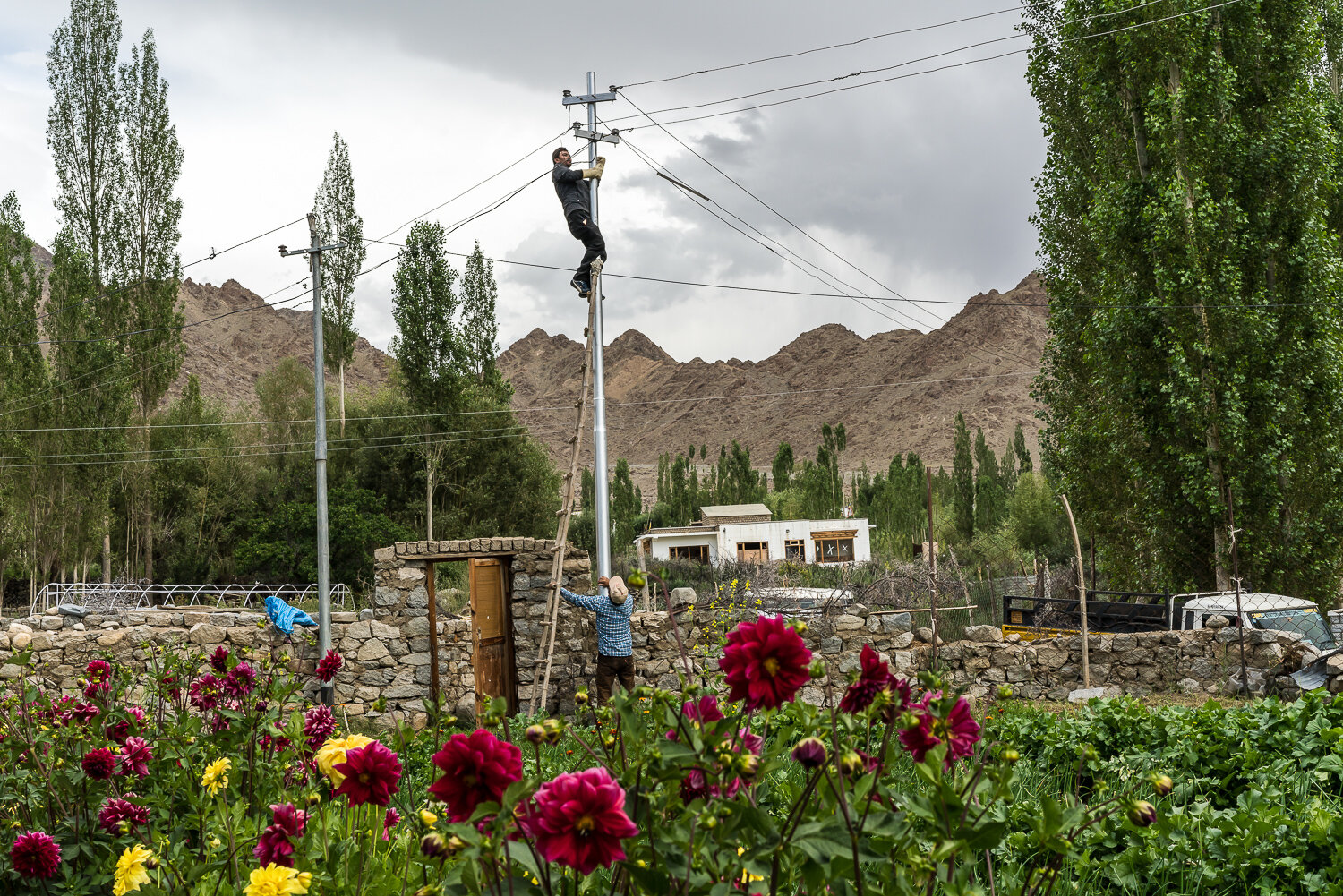
Tashi Motup, on the ladder, and Jigmat Lundup, local linemen, connect electric lines to a house on Tuesday, August 13, 2019 in Saboo, Ladakh, India. India has made a concerted effort in recent years to supply electricity to rural villages all over the country that never before enjoyed access, increasing demand and necessitating the construction of hydroelectric dams on the Indus River and its tributaries that have been a source of tension with downstream neighbor Pakistan.

Sant Balbir Singh Seechewal, a Sikh guru, gives a tour of the local water treatment plant he created on Saturday, August 5, 2017 in Seechewal, Punjab, India. Baba Ji's method of treating polluted local waterways in order to purify the water and redirect it for agriculture and recharging groundwater aquifers has come to be known as the Seechewal Model, and is being implemented across Punjab and elsewhere in India. Its cost-effectiveness and simplicity offer hope for addressing ever-increasing water needs sustainably.
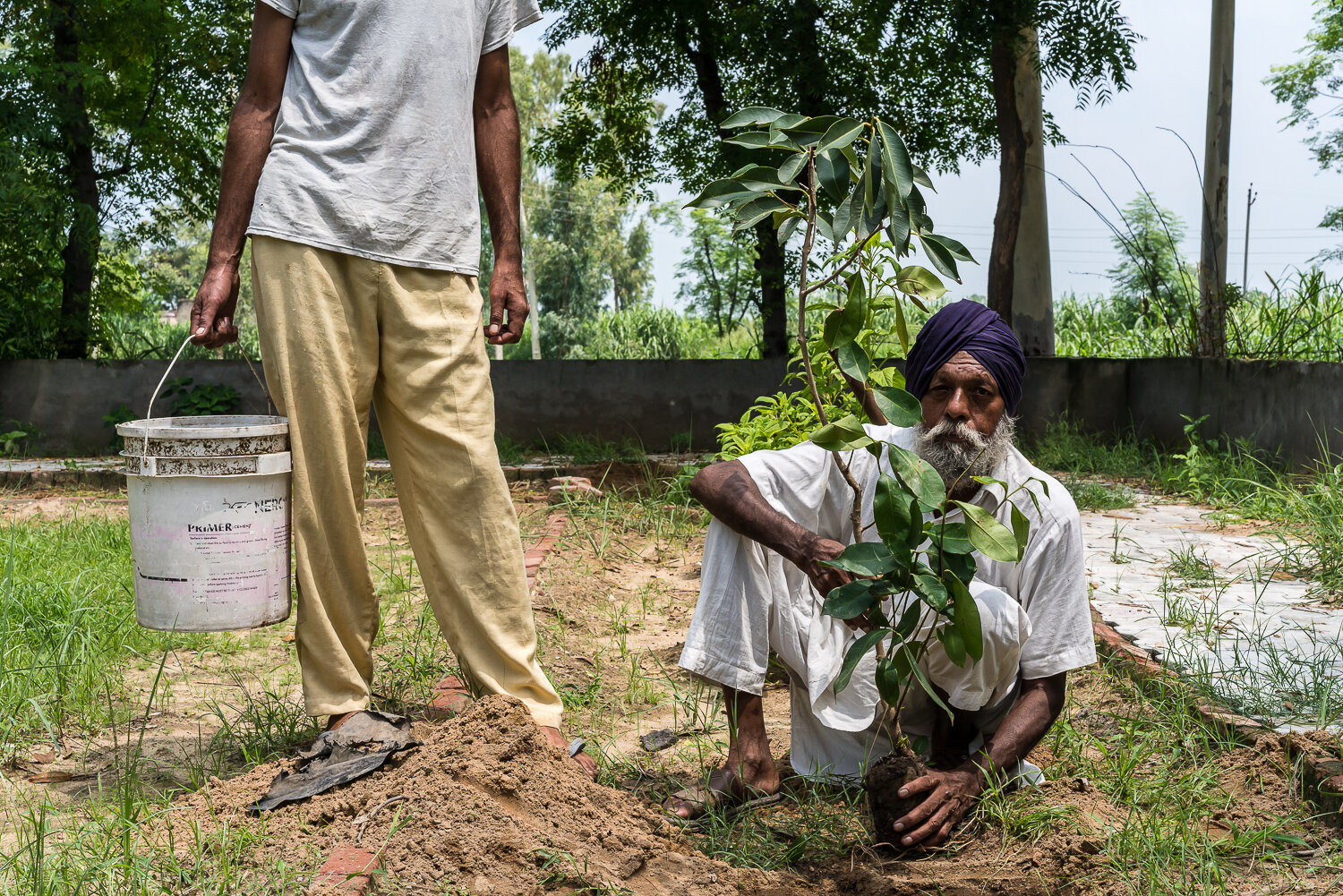
Community members including Charn Das, right, gather to plant trees in a park named for Sant Baba Balbir Singh Seechewal, a local Sikh guru who has spearheaded an environmental movement based on simple, low-cost solutions, on Sunday, August 4, 2019 in Sherpur Dona, India.

Nisham Singh, 45, a truck driver, bathes at a well adjacent to the Beas River on Monday, August 7, 2017 in Beas, Punjab, India. The Beas is a tributary of the Indus River.

Visitors pose for pictures with border guards following the daily border closing ceremony at the border with India on Friday, November 24, 2017 in Wahga, Punjab, Pakistan. The ceremony draws large crowds on both sides of the border for a nationalistic display and the cultivation of patriotic pride.
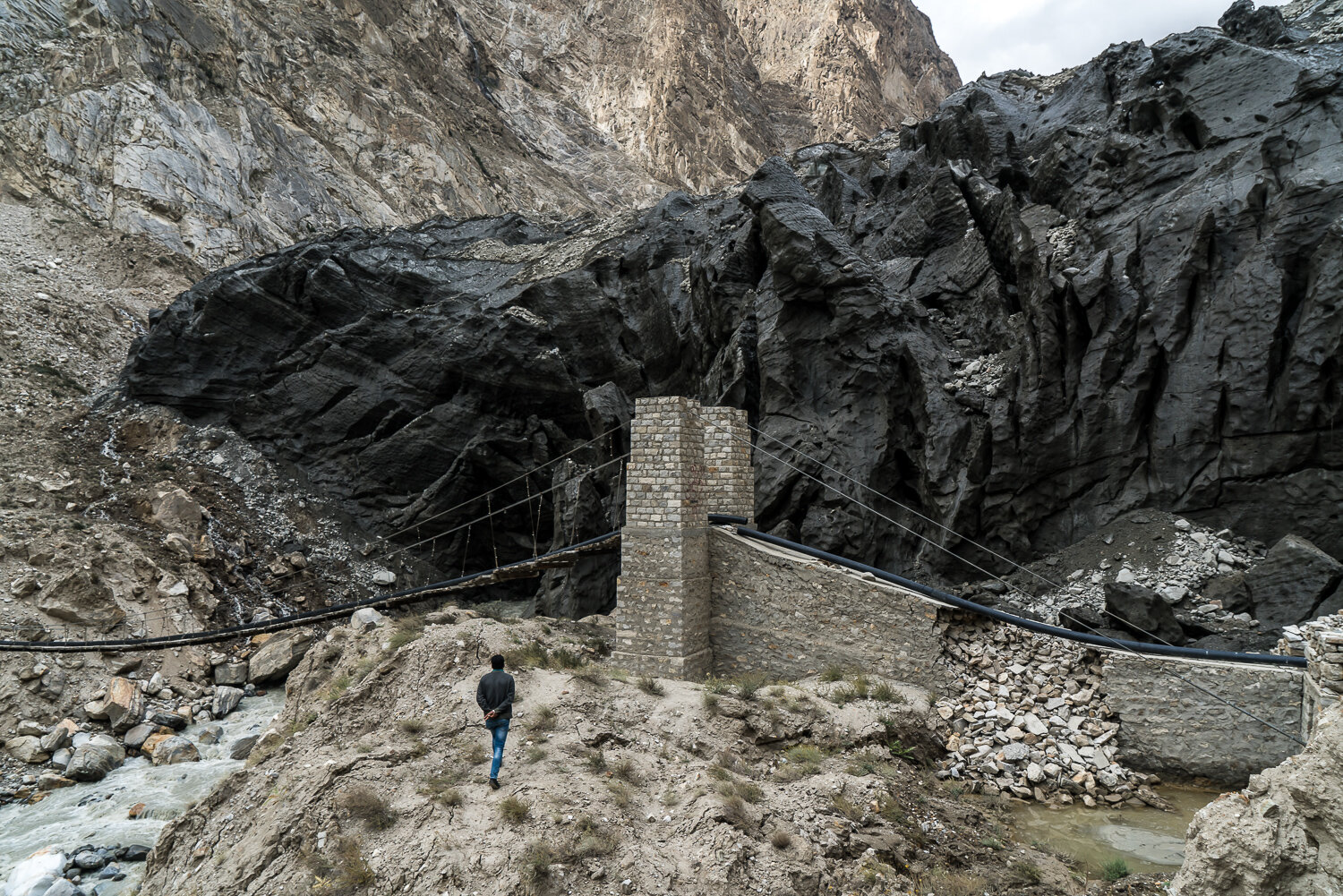
Majeed Ullahbaig walks to a bridge located in front of the Shisper glacier on Friday, October 4, 2019 in Hasanabad, Gilgit-Baltistan, Pakistan. The glacier provides water for drinking and irrigation, but has recently surged downhill substantially, requiring the construction of a new pumping station and the rerouting of water pipes.

Men along the Chenab River on Saturday, November 18, 2017 in Bosan, Punjab, Pakistan. The Chenab is one of the main tributaries of the Indus River.

A man fills bottles with water at a community tap on Monday, November 20, 2017 in Lahore, Punjab, Pakistan. Many parts of the city do not have running water in every house, and in those that do the water is unsafe to drink. In 2018 Lahore was forced to begin rationing water as underground aquifers are rapidly depleted.
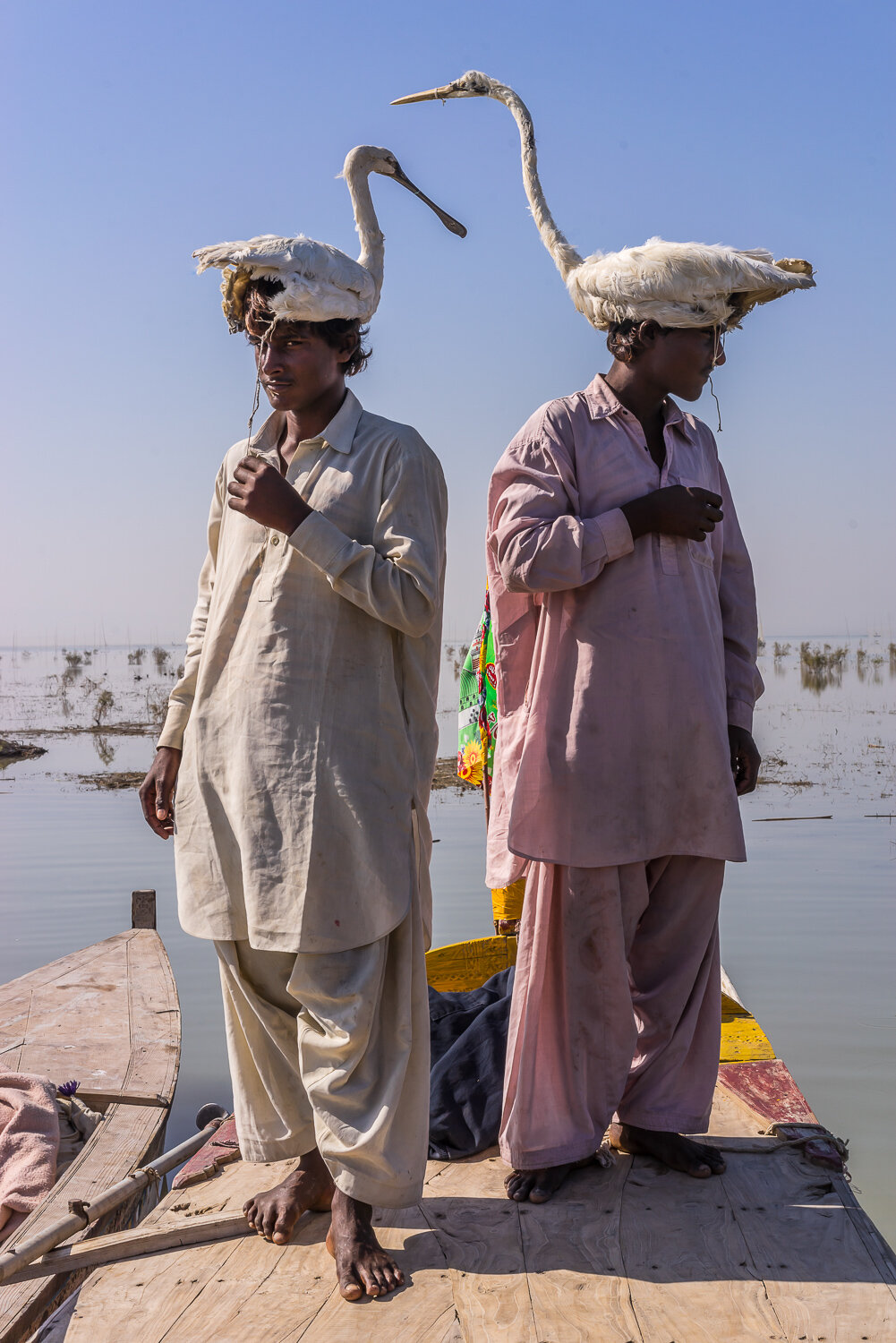
Residents of the floating village on Manchar Lake pose for a portrait with artificial birds, which they use to disguise themselves for bird hunting, on Monday, November 27, 2017 on Manchar Lake, Sindh, Pakistan. Due to the lake becoming more polluted and a reduction in the fresh water inflow from the Indus River, the fish count in the lake is way down, forcing many residents off their boats. The lake was once a popular stopover for migrating birds, but with fewer fish to feed on, the birds have gone elsewhere.
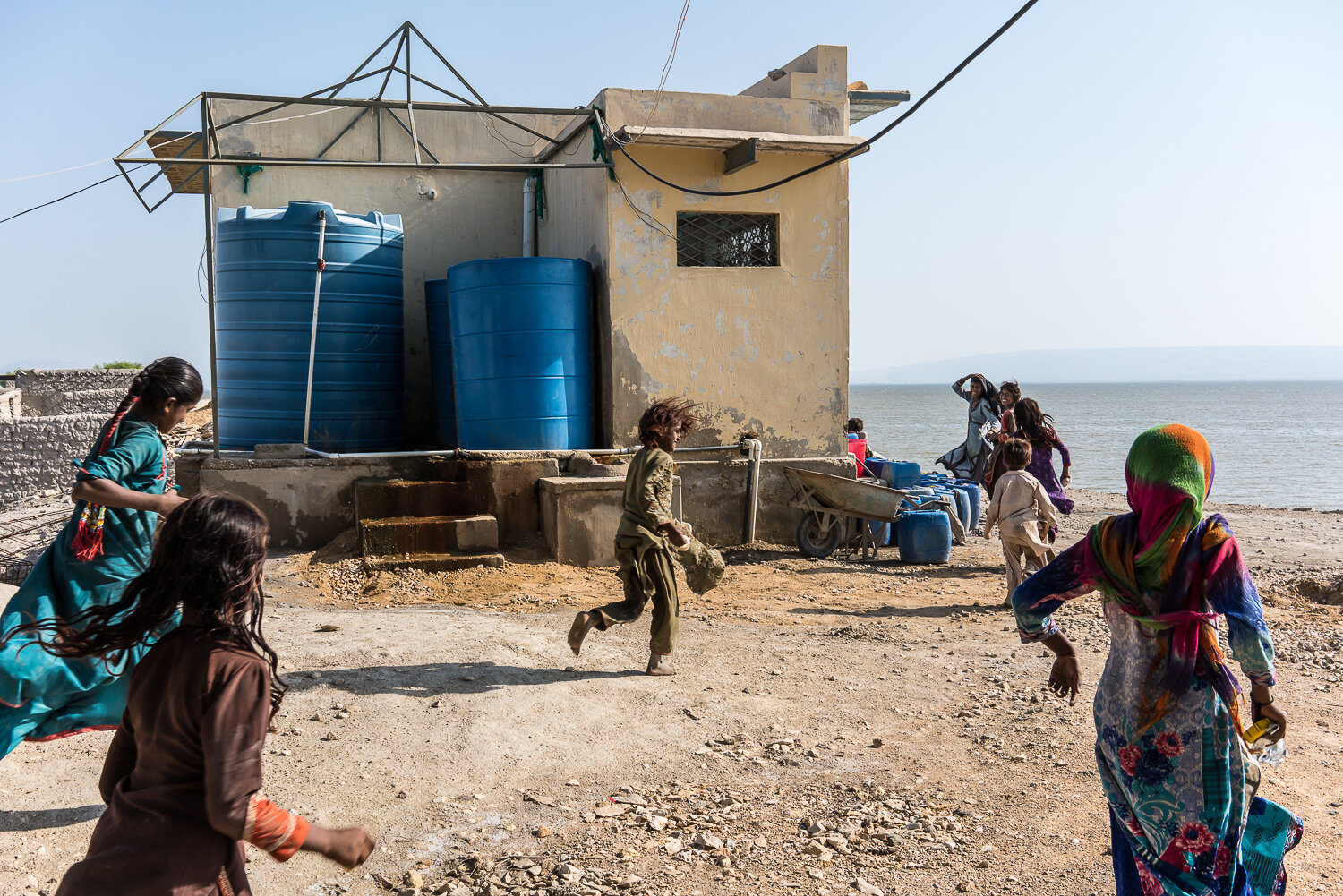
Children run to a reverse osmosis water filtration plant in anticipation it will turn on so they can draw water on Saturday, September 28, 2019 in Manchar, Sindh, Pakistan. Manchar is the largest freshwater lake in Pakistan, but its water has become too polluted from pesticides and fertilizers to drink.
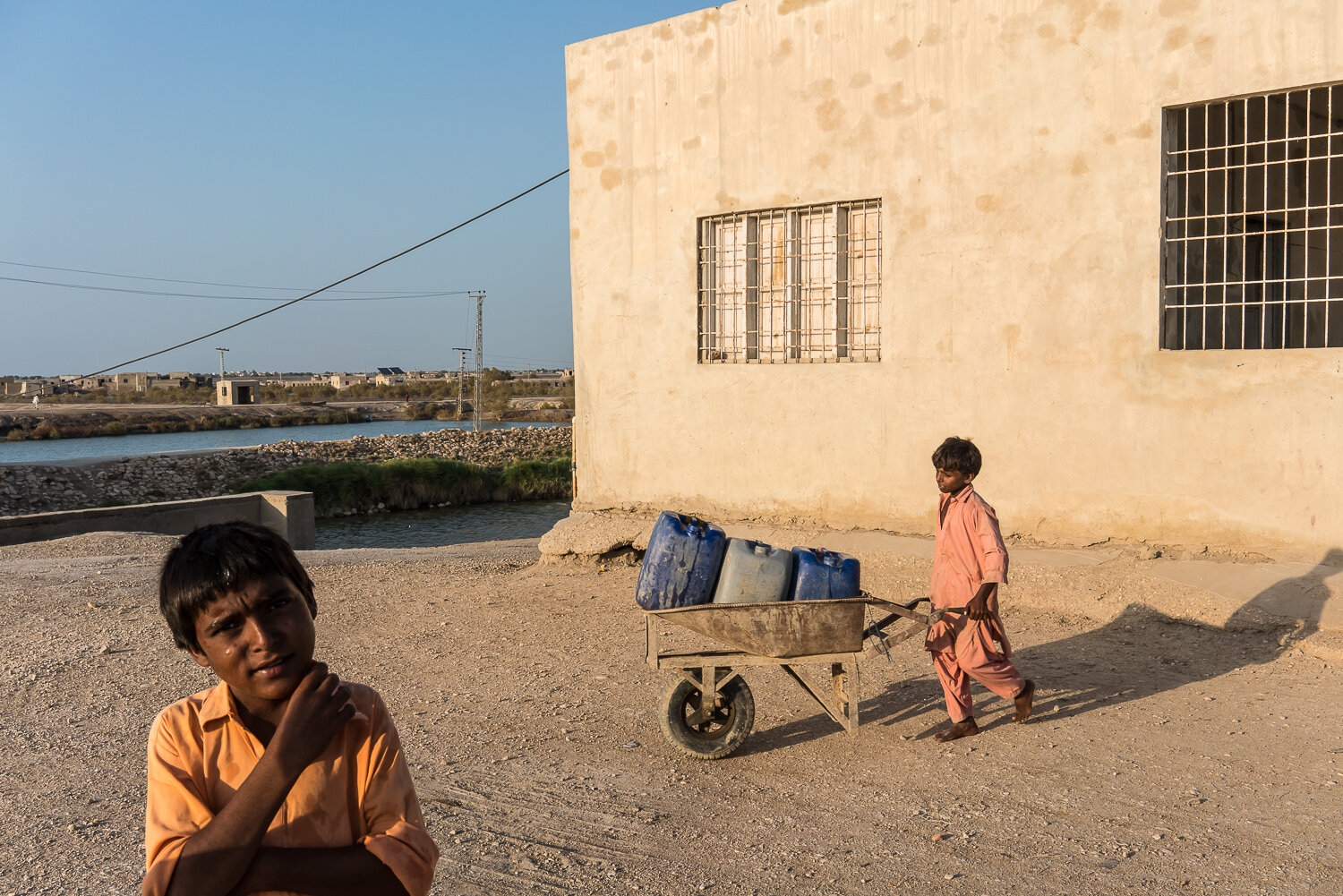
Children collect drinking water from a reverse osmosis plant on the shores of Lake Manchar on Saturday, September 28, 2019 in Manchar, Sindh, Pakistan. The lake itself used to provide all the fresh water necessary, but it is now too polluted to drink.
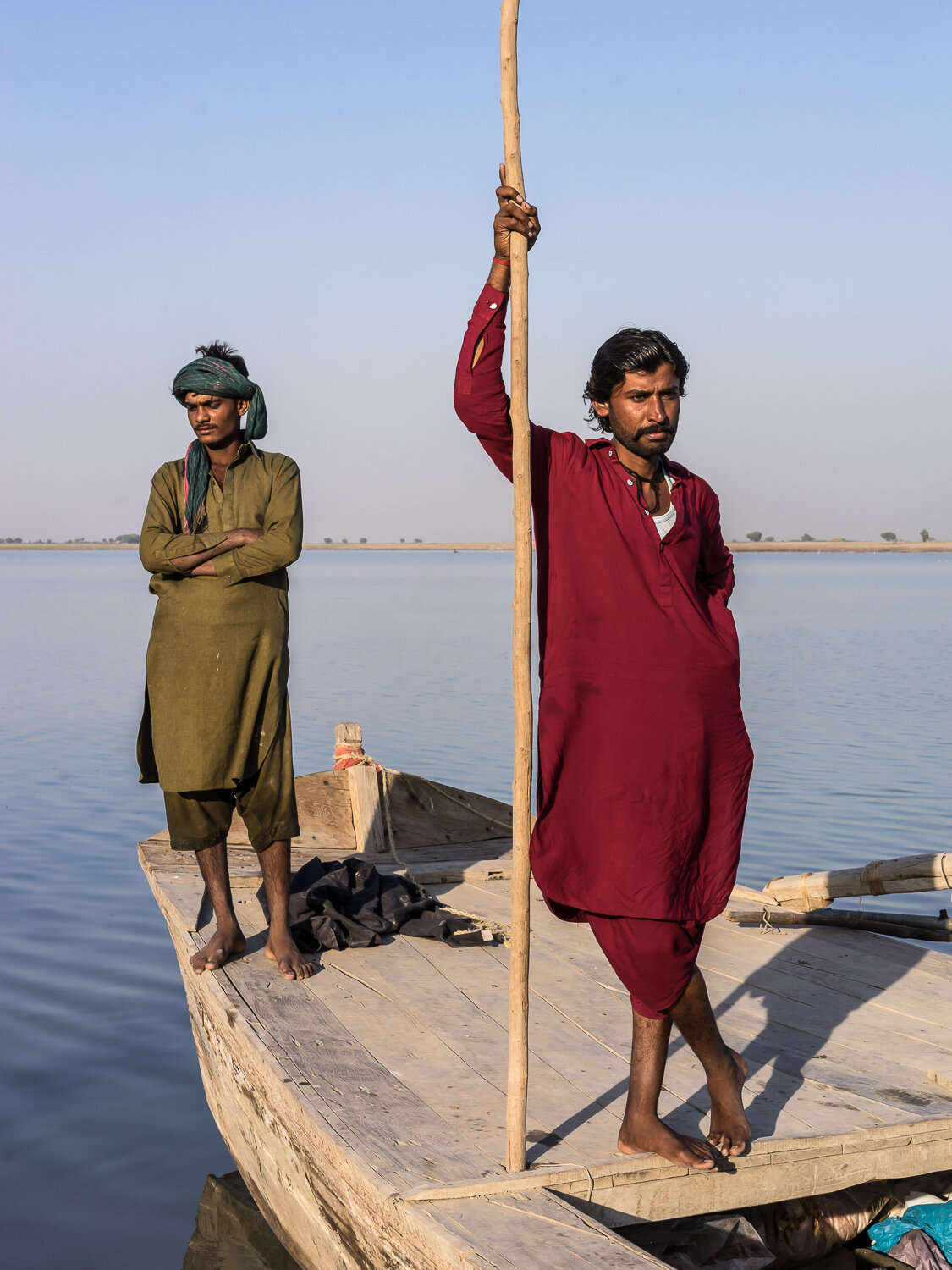
Boatmen on the Indus River on Monday, November 27, 2017 in Sehwan Sharif, Sindh, Pakistan. The Indus and its tributaries form the backbone of Pakistan's fresh water supply, and a series of river-fed canals irrigate the fields that support much of the country's agriculture. Today, a rapidly-growing population is straining water supplies, while tensions with India, from which the Indus flows, threaten to further reduce the flow.
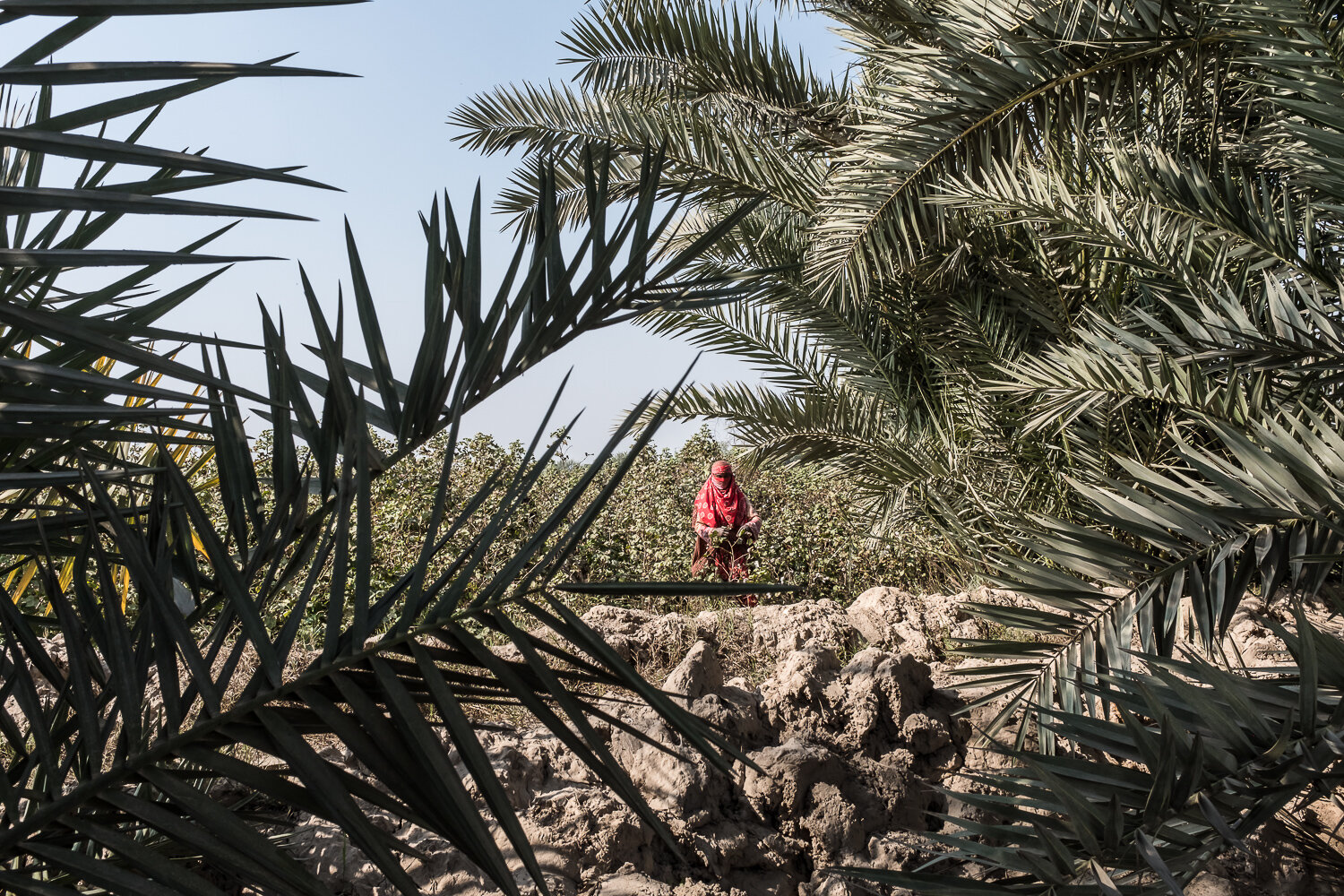
A woman harvests cotton on Sunday, November 19, 2017 in Tiba Sultanpur, Punjab, Pakistan. Cotton is a very water-intensive crop to grow, but it is a major agricultural commodity for Pakistan; the cotton and textile industries bring more than half of Pakistan's foreign exchange earnings.

A cotton plant inside a greenhouse at the Central Cotton Research Institute on Saturday, November 18, 2017 in Multan, Punjab, Pakistan. The institute is one of several around the country where scientists are attempting to develop new cotton varieties that will thrive with less water and in the higher temperatures climate change is expected to bring.
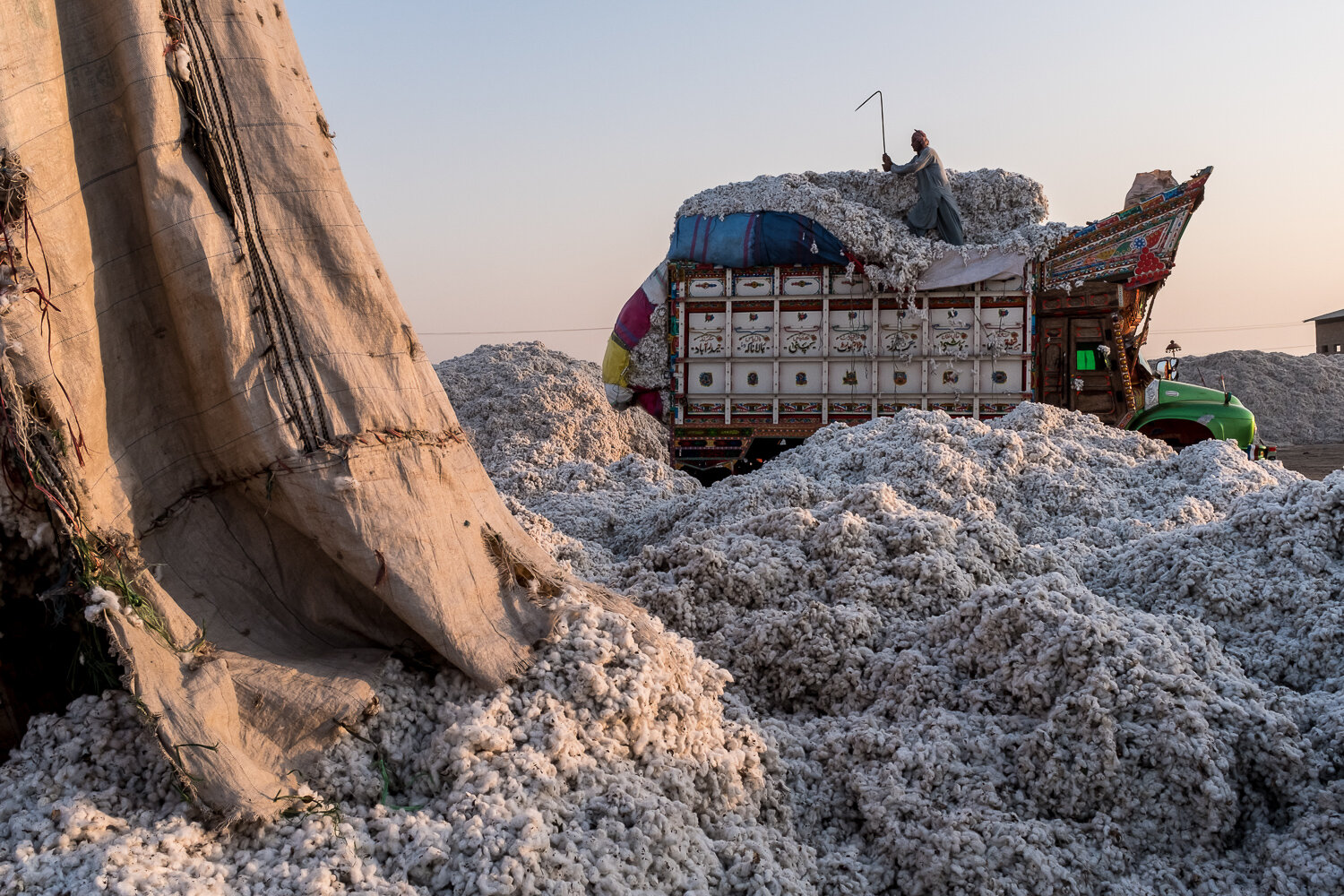
A truck delivering recently-picked cotton is unloaded at Usman Marvandi Cotton Industries on Tuesday, November 28, 2017 in Bubak, Sindh, Pakistan. Cotton is a very water-intensive crop to grow, but it is a major agricultural commodity for Pakistan; the cotton and textile industries bring more than half of Pakistan's foreign exchange earnings.

A worker tends to a fabric dyeing machine at MK Sons, a textile factory, on Wednesday, November 22, 2017 near Khurianwala, Punjab, Pakistan.
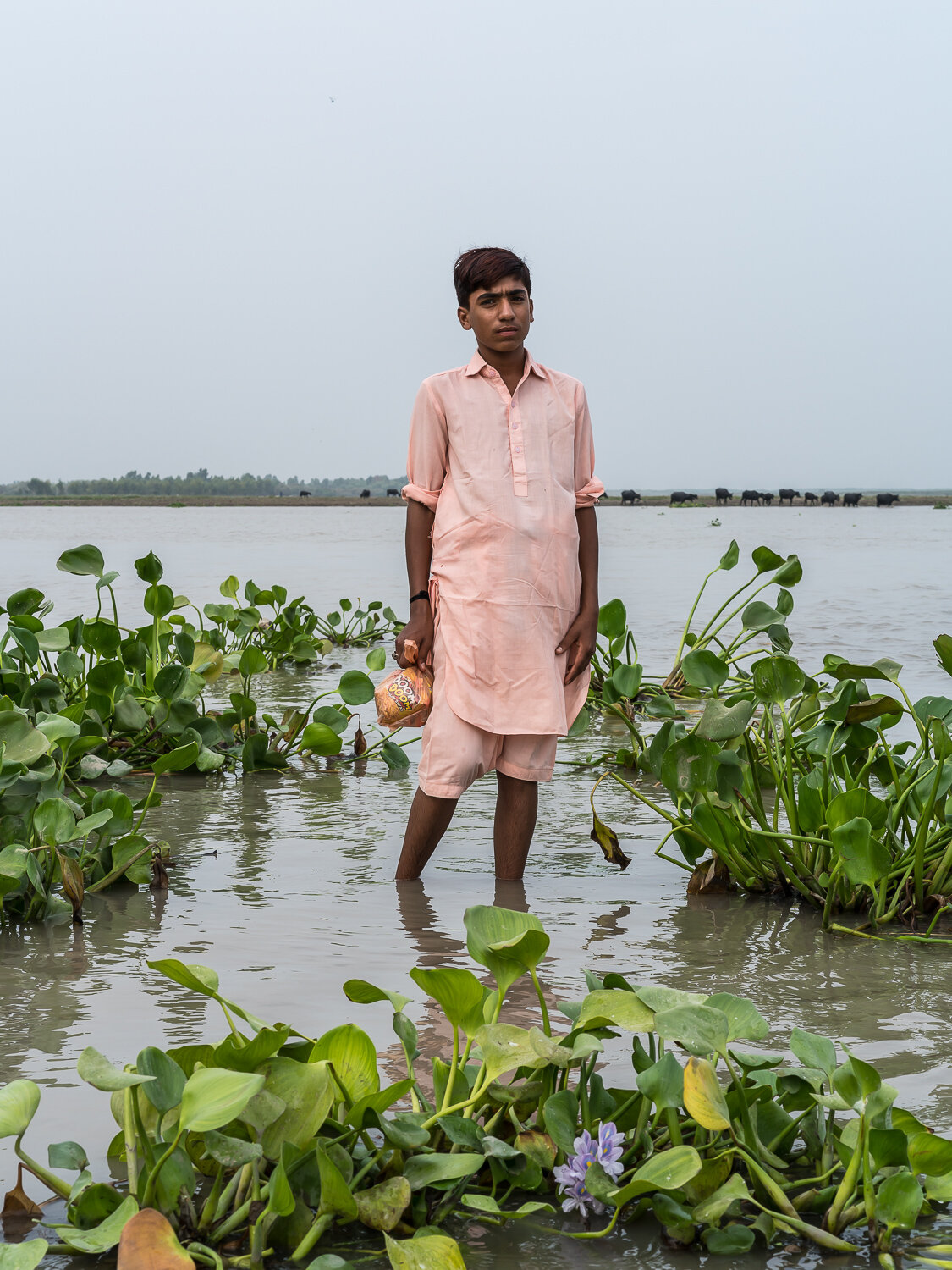
Ijaz Mallah, who herds buffaloes in the shallows of the Indus River, poses for a portrait on Wednesday, October 2, 2019 in Sukkur, Sindh, Pakistan.
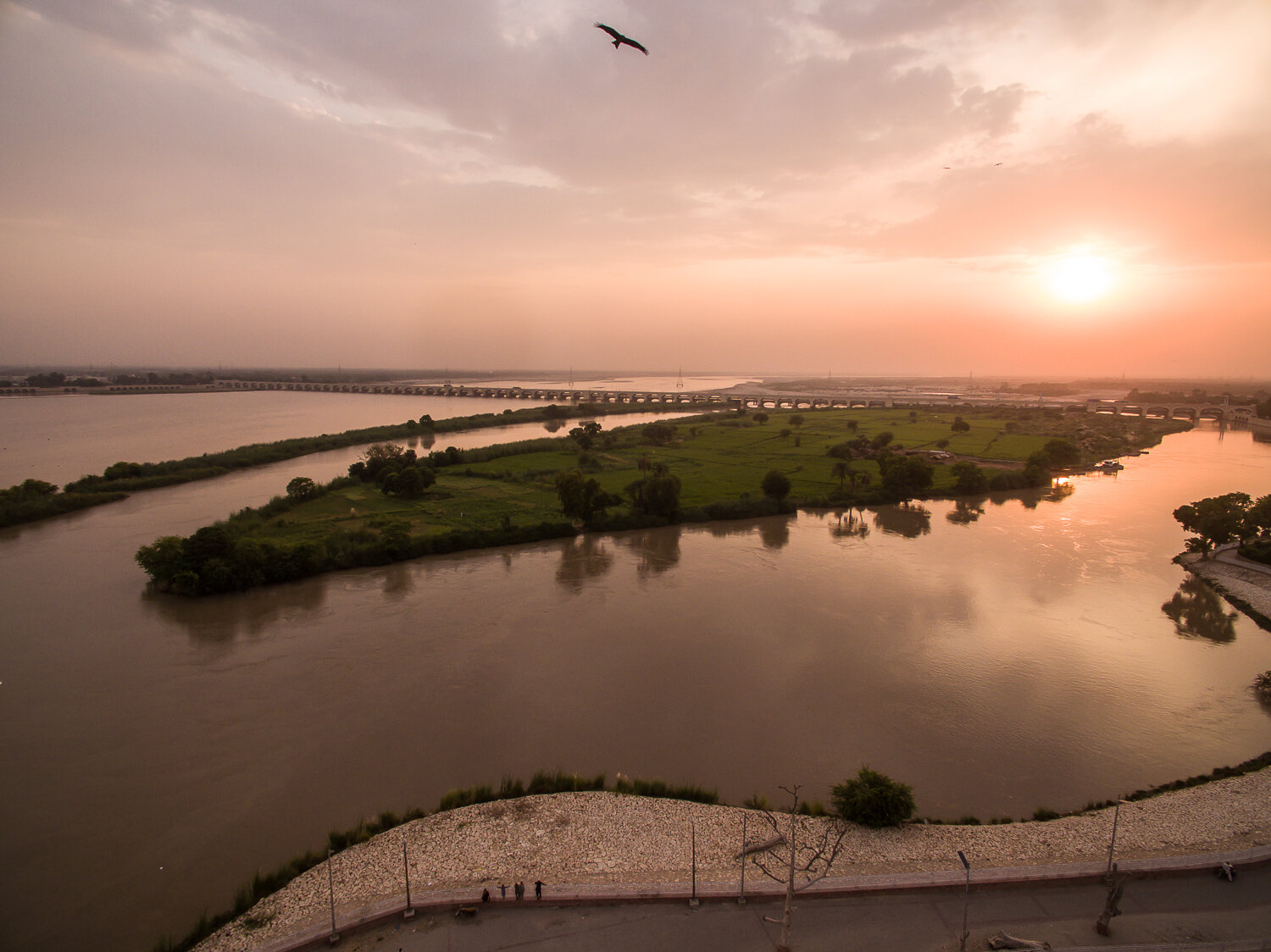
The Indus River and Sukkur Barrage are seen from a drone on Wednesday, October 2, 2019 in Sukkur, Sindh, Pakistan. The Sukkur Barrage helps supply water to the world's largest network of irrigation canals - more than 6000 miles worth. Excessive water use in what would otherwise be a desert means the Indus rarely flows all the way to the delta on the Arabian Sea.
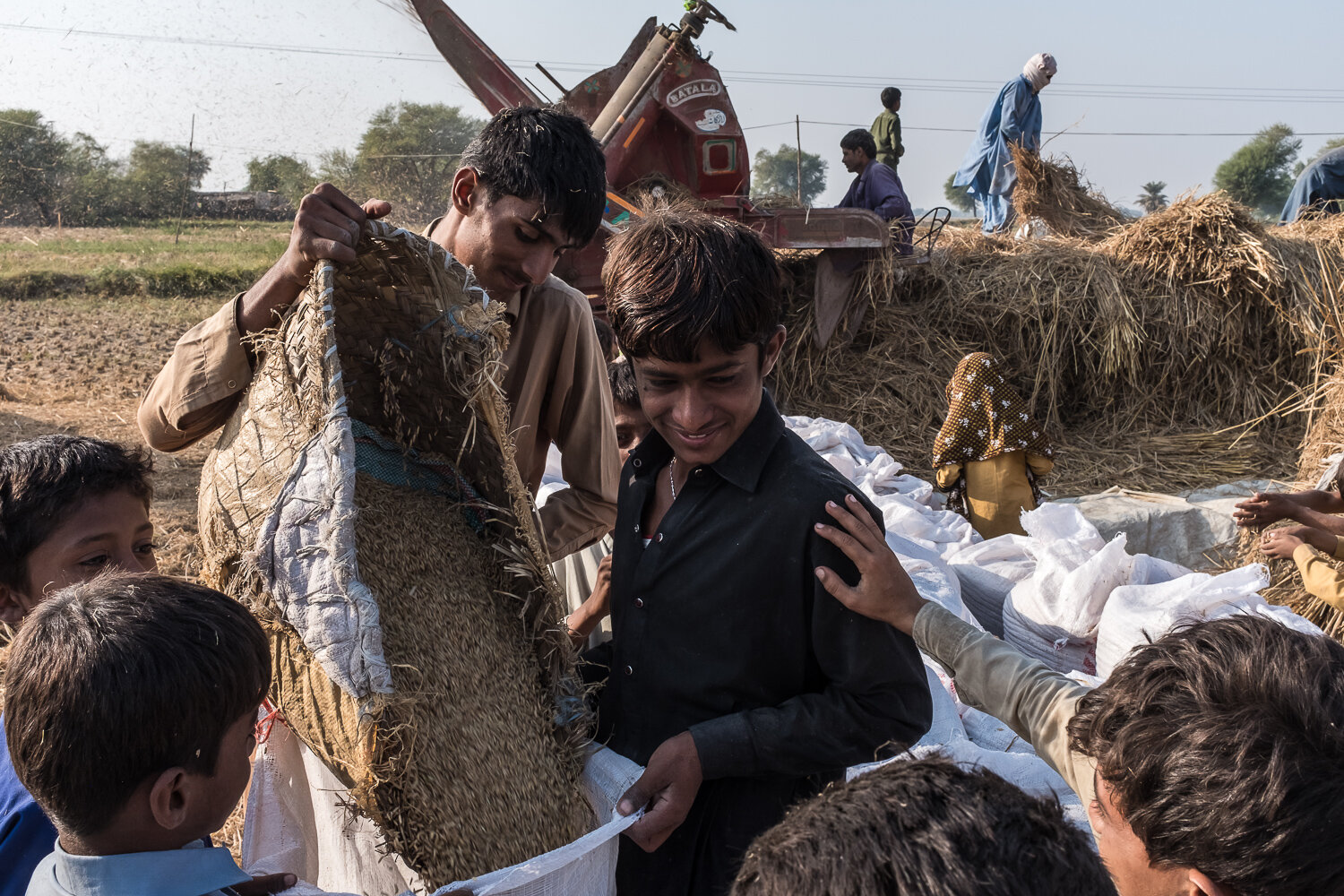
Local villagers, most of whom belong to one extended family, threshing rice on Tuesday, November 28, 2017 in Khairpur Nathan Shah, Sindh, Pakistan. Sindh receives little rain outside of the monsoon season, and most agriculture is made possible by irrigation canals that draw water from the Indus River and its tributaries, or from an underground aquifer that is rapidly depleting.
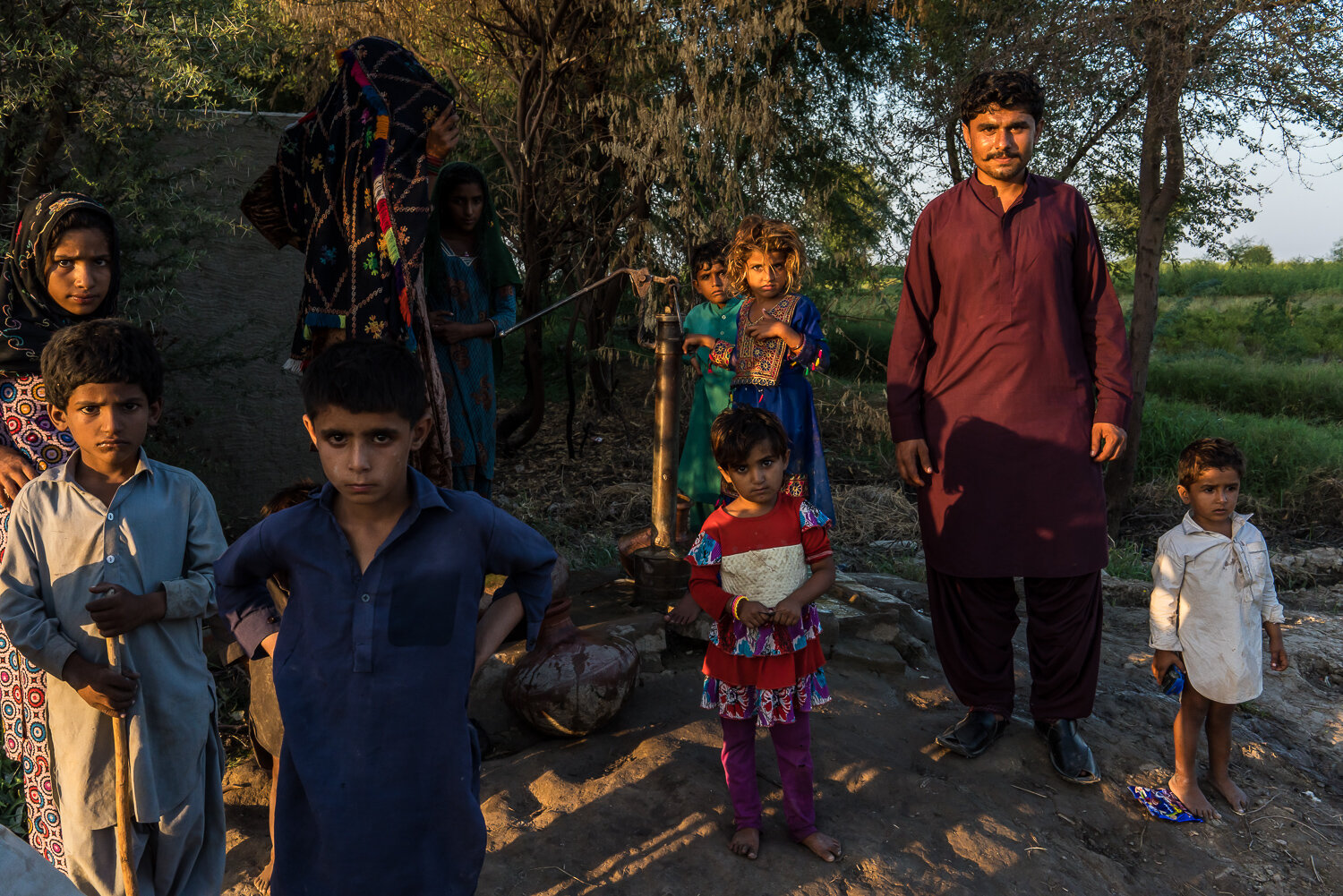
Hindu villagers draw water from a hand pump on Tuesday, October 8, 2019 in the Thar desert village of Rano Rahimoo, Sindh, Pakistan. Polluted groundwater has caused an epidemic of kidney problems in the village of 150 people.
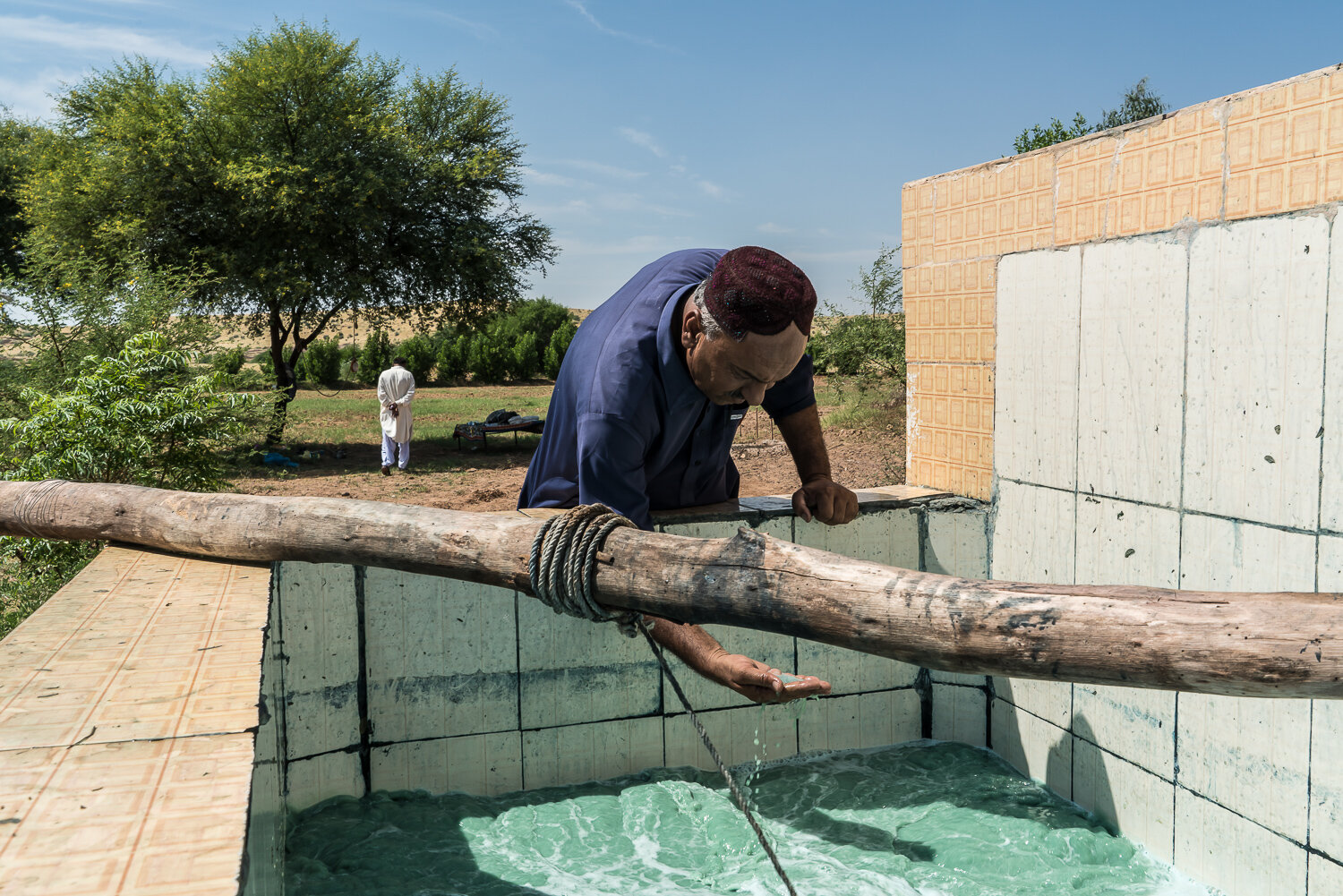
Abdul Qadir Palari, 51, checks his product as he processes indigo dye on Sunday, October 13, 2019 in Bhaloo Khan Palari, Sindh, Pakistan. Indigo is a native species and can grow without excessive use of irrigation, pesticides, or fertilizer, providing an environmentally friendly crop that is an alternative for locals after the collapse of the fishing industry on nearby Lake Keenjhar, which is fed by the Indus River.
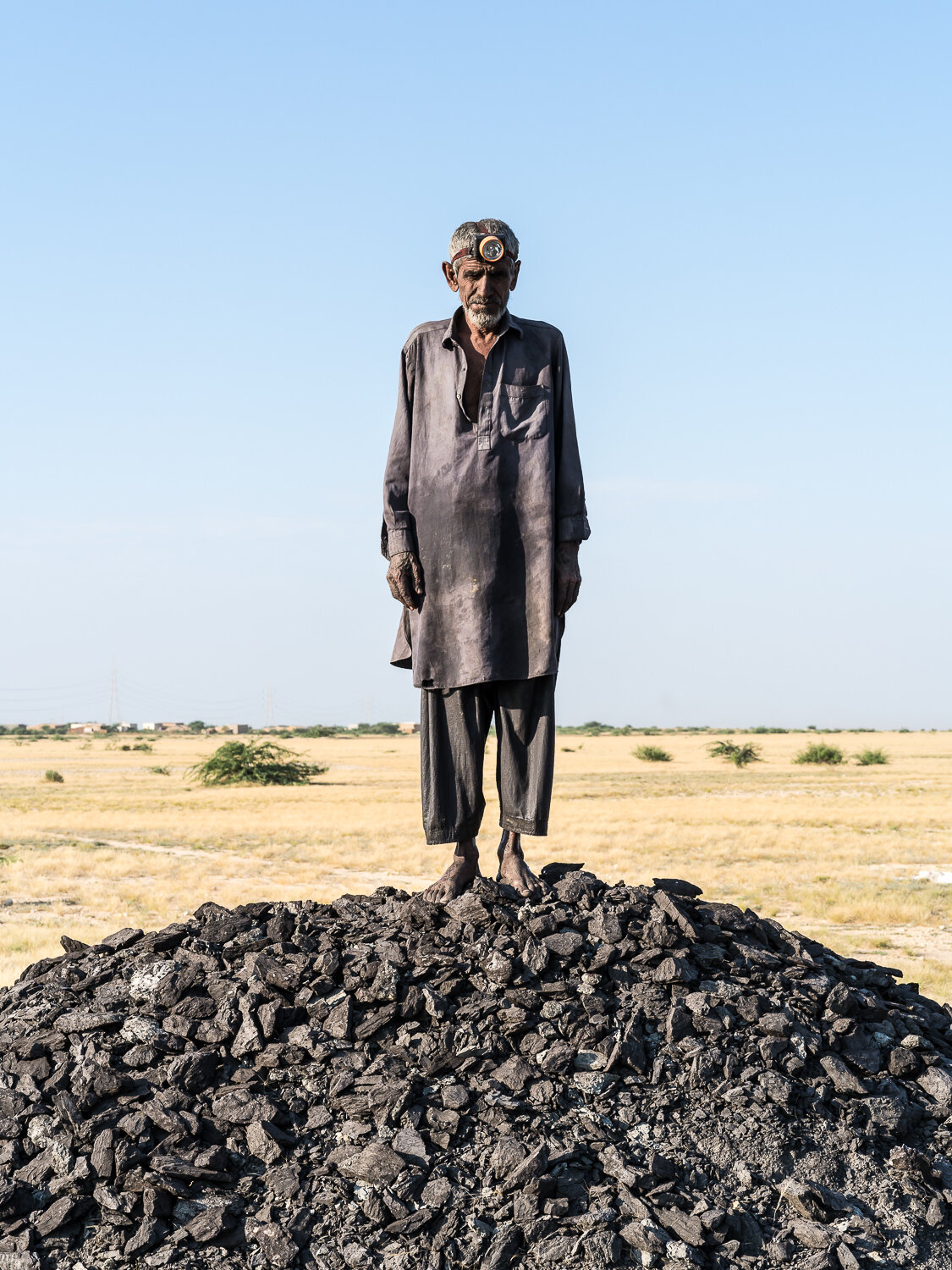
Jan Muhammad Khaskheli, 65, poses for a portrait at the Lucky Coal Mine where he has worked for the past three years on Monday, October 14, 2019 in Jhampir, Sindh, Pakistan. Before working as a coal miner, Khaskheli was a lifelong fisherman on Lake Keenjhar, but a lack of fish forced him to seek other work.

A market stall selling fish from Keenjhar Lake on Friday, December 1, 2017 in Thatta, Sindh, Pakistan. The lake is an important stopover point for migrating birds, but its health is affected by reduced inflow from the Indus River, meaning there are fewer fish for the birds as well as for people.
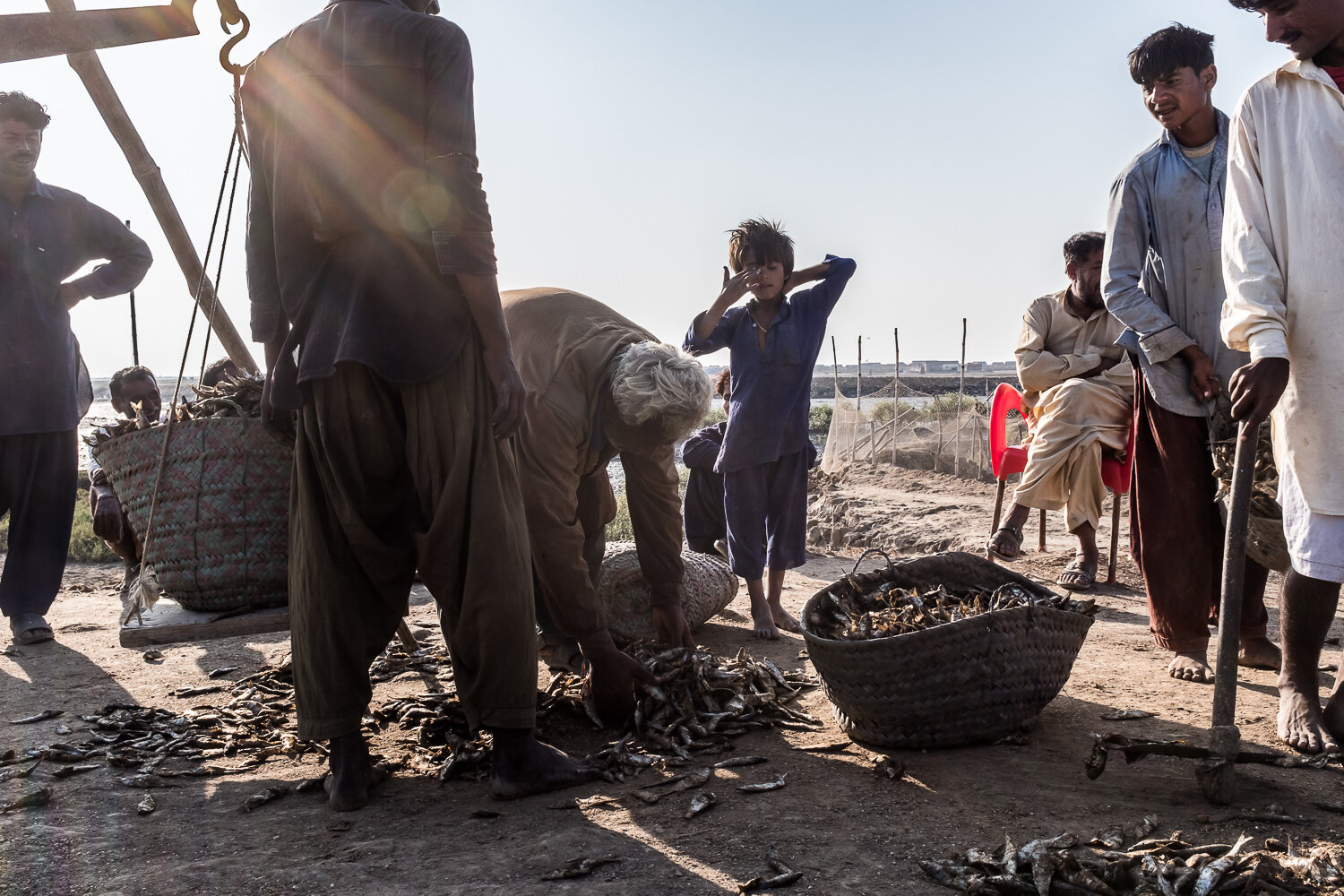
Fishermen weigh dried fish on Friday, December 1, 2017 in Keti Bandar, Sindh, Pakistan. At the very tip of the Indus River delta, fishing is no longer as lucrative as it once was, due to reduced river flows and fewer fish. As a result, fishermen are forced to go out of the river and into the Arabian Sea; occasionally, Pakistani fishermen stray accidentally into Indian territorial waters, where they can be arrested and detained.
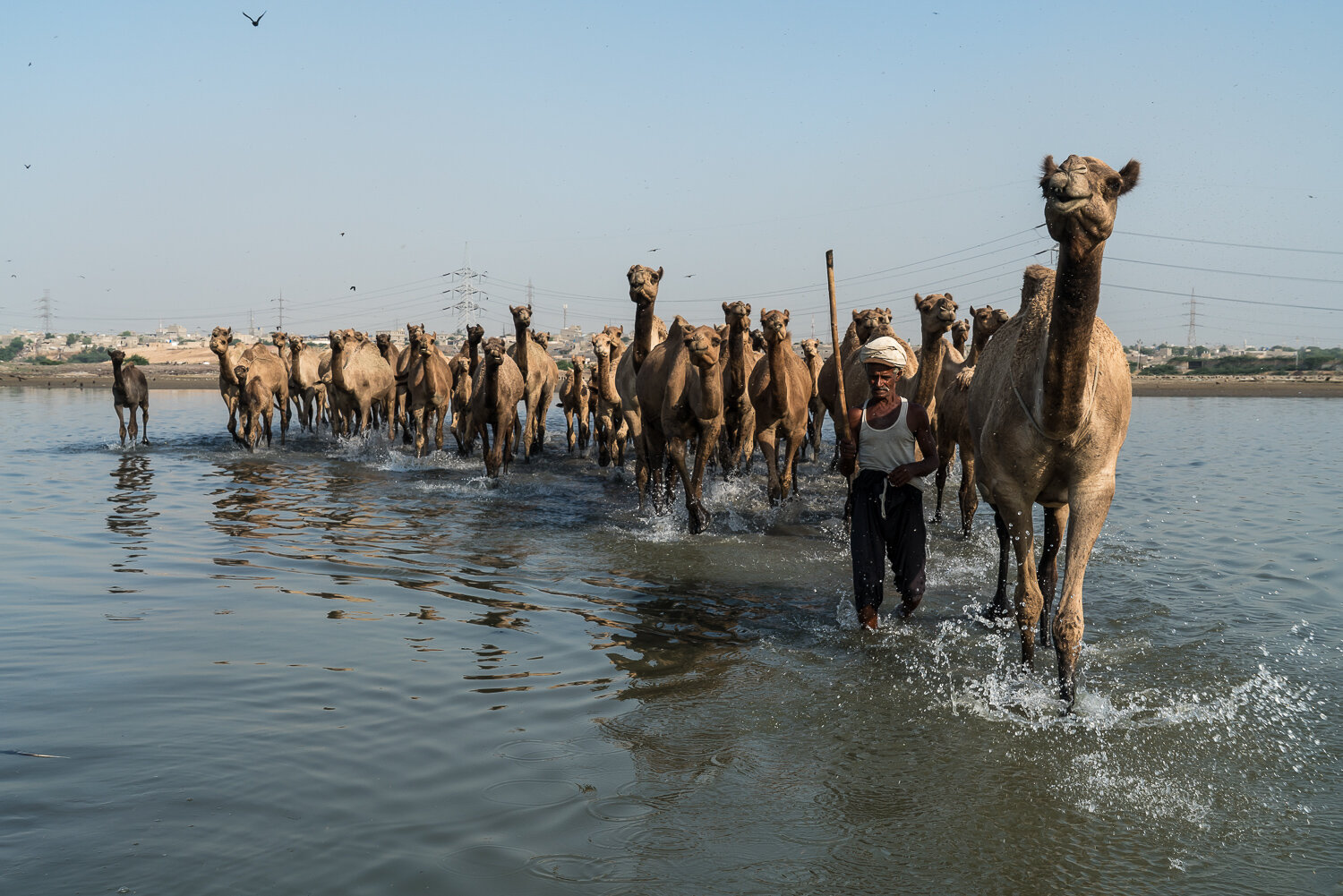
A herd of camels is led to graze on mangroves in the Indus River delta on Saturday, October 12, 2019 in Ibrahim Hyderi, Sindh, Pakistan.

A fisherman in the mangroves of the Indus River delta on Tuesday, October 8, 2019 in Rehri Goth, Sindh, Pakistan.
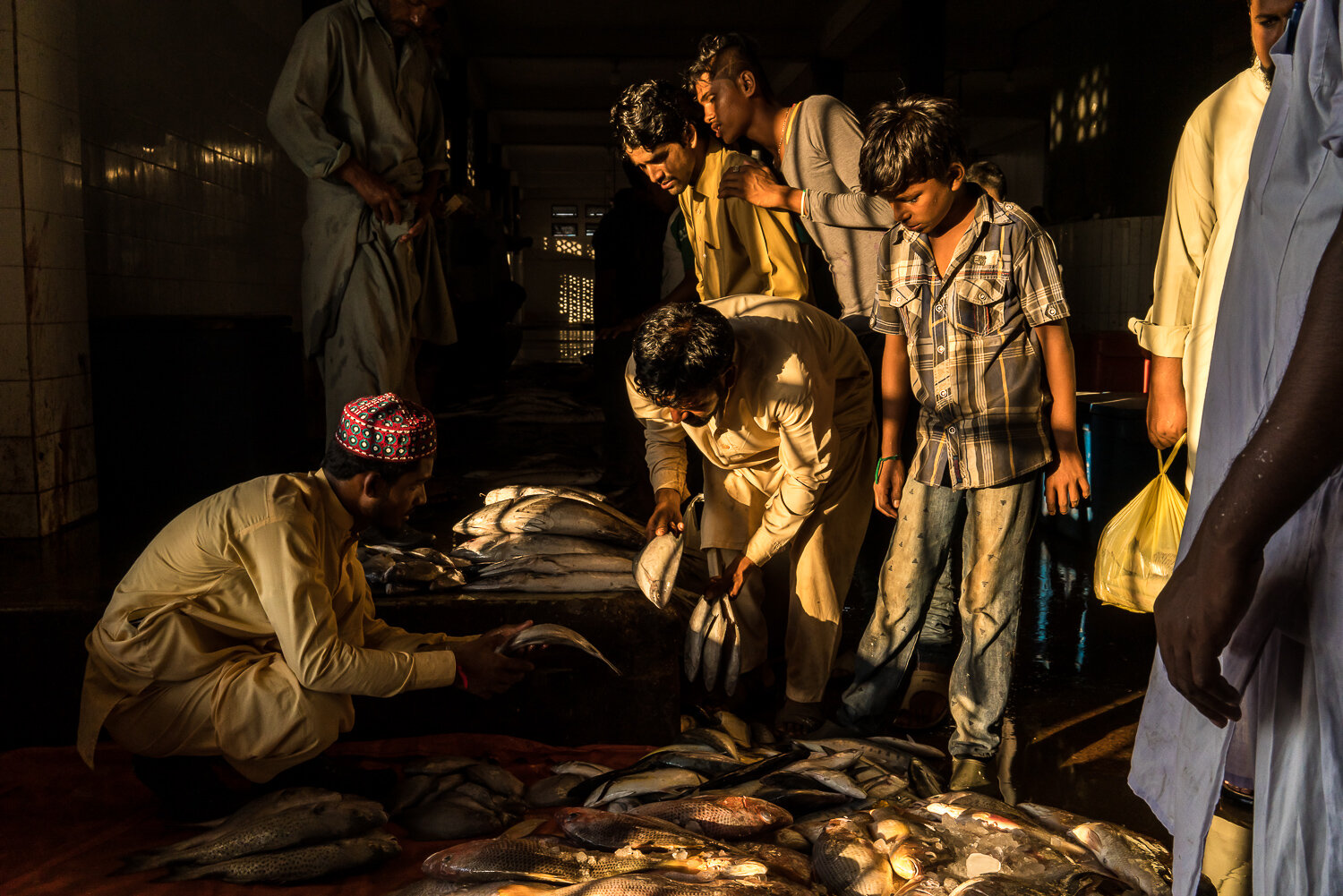
Buyers inspect fish for sale in the main Karachi fish market on Saturday, October 12, 2019 in Karachi, Sindh, Pakistan.

Salim Rahu, 29, left, drills a bore well to provide fresh water for residents of a house as his colleague Shabeer, 19, right, relaxes on Saturday, October 12, 2019 in Karachi, Sindh, Pakistan. A large portion of Karachi's water supply is siphoned off illegally, meaning many residents pay for municipal water but don't receive it, and are forced then to buy water from tanker trucks or, if they can afford it and live in a part of the city far enough from the sea, drill a private well.
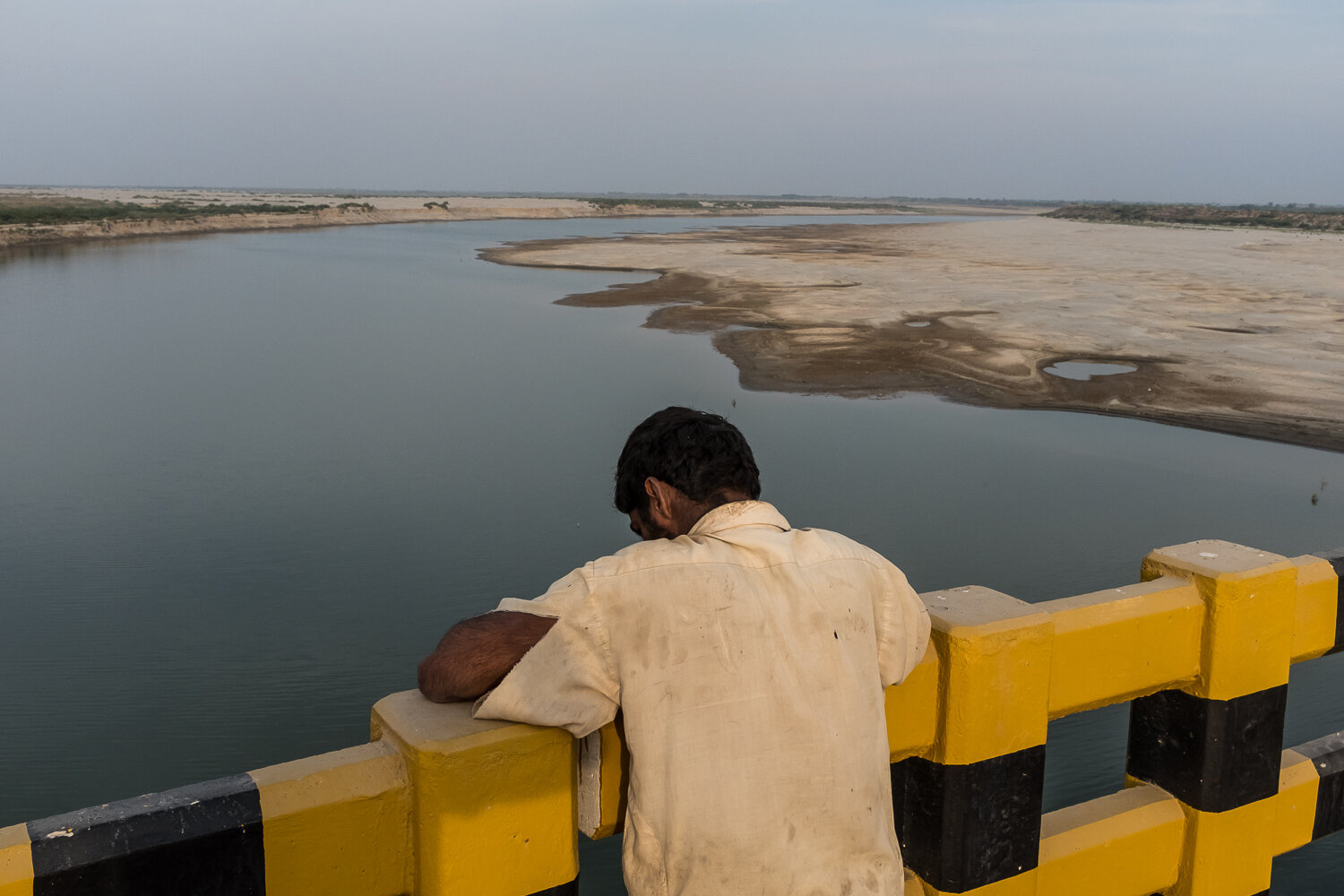
A man looks out from a bridge at the lower Indus River at dusk on Saturday, December 2, 2017 near Thatta, Sindh, Pakistan.
PROJECTS
Saving the Indus River
By Brendan Hoffman
The Indus River, one of Asia's longest, originates high on the Tibetan plateau of western China, drawing additional water from the glaciers of India before crossing the border and flowing the length of Pakistan. It is used for extensive irrigation of commercial and food crops, industry, and to provide hydroelectric power. It is a vital resource, especially for India and Pakistan, yet several factors are making heavy reliance on the Indus increasingly difficult to sustain.
First, the Indus flows from Pakistan's rival India, which thanks to an extensive and growing dam network has the power to drastically reduce the water allowed through to Pakistan. A 1960 treaty defines which Kashmiri headwaters India and Pakistan control, though recent military disputes and disagreements over India's efforts to utilize the river in its territory have raised questions about its ability and intention to essentially weaponize water.
Second, climate change is affecting the monsoon rains and many of the glaciers that are a major source of the river's water, throwing into doubt both India's and Pakistan's long-term economic dependence on the river. Paradoxically, this has contributed to recent flooding as some glaciers melt more than normal, but once they have shrunk water flows will be less than necessary to sustain the economy built on the Indus. Only a small fraction of the thousands of glaciers feeding the Indus have been studied in a meaningful way, and so the ultimate consequences of climate change are poorly understood.
Finally, Pakistan, with a rapidly growing population, has the most water-intensive economy in the world, and is already water-stressed based on the amount of fresh water available per person. Its economic reliance on the Indus is extreme; in addition to rice and wheat, the water-intensive cotton and textile industries make up a significant part of its GDP and foreign exchange earnings. Major changes are necessary to make agriculture and irrigation more efficient, yet to do so will require scientific advances and taking on corrupt interests unlikely to yield.
As the political and economic stakes continue to grow, will the dispute over the Indus launch a water war?
Publications
A water crisis looms for 270 million people as South Asia’s glaciers shrink, National Geographic Magazine, July 2020
